Music is the universal language
“Glory to God in the highest heaven, and on earth peace to those on whom his favor rests.” - Luke 2:14
Premier Guitar
Rig Rundown Best Of: Legendary Gibson ES-335 Stories and Setups
From Tom Bukovac’s first-year ’58 to Larry Carlton’s iconic ’69 and Molly Miller’s well-worn ’78, this PG best-of Rig Rundown celebrates the artists who made the ES-335 their own. Hear Charlie Worsham’s Vince Gill gift story, Tim Pierce’s player-grade philosophy, and Sturgill Simpson’s stage-shaking tones—plus why so many pros trust this semi-hollow classic.
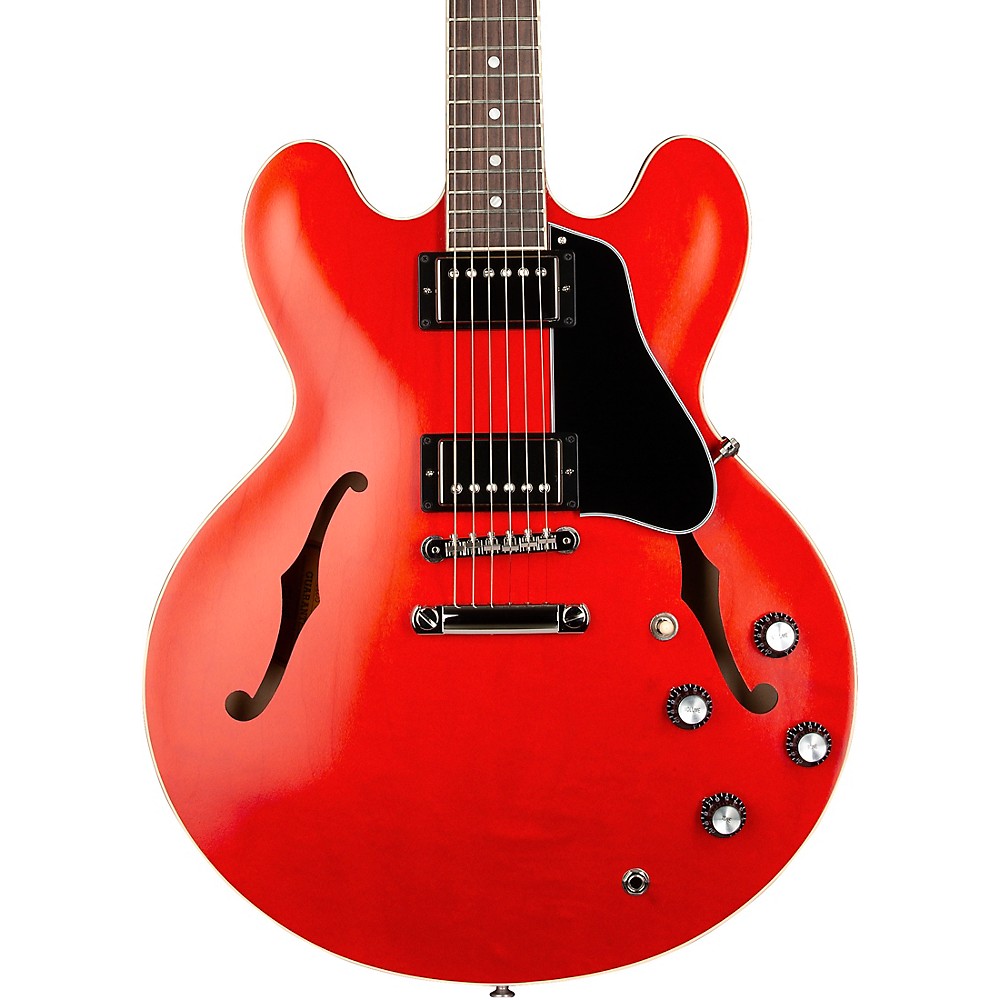
Gibson ES-335 Satin Semi-Hollow Electric Guitar Satin Cherry
Steve Gunn Announces Daylight Daylight; Shares “Nearly There”

Steve Gunn has been at the vanguard of American experimental / guitar-oriented rock music for over a decade. After a trio of acclaimed albums recorded for Matador, Gunn will release his 7th studio record – and first in 4 years – on November 7th.
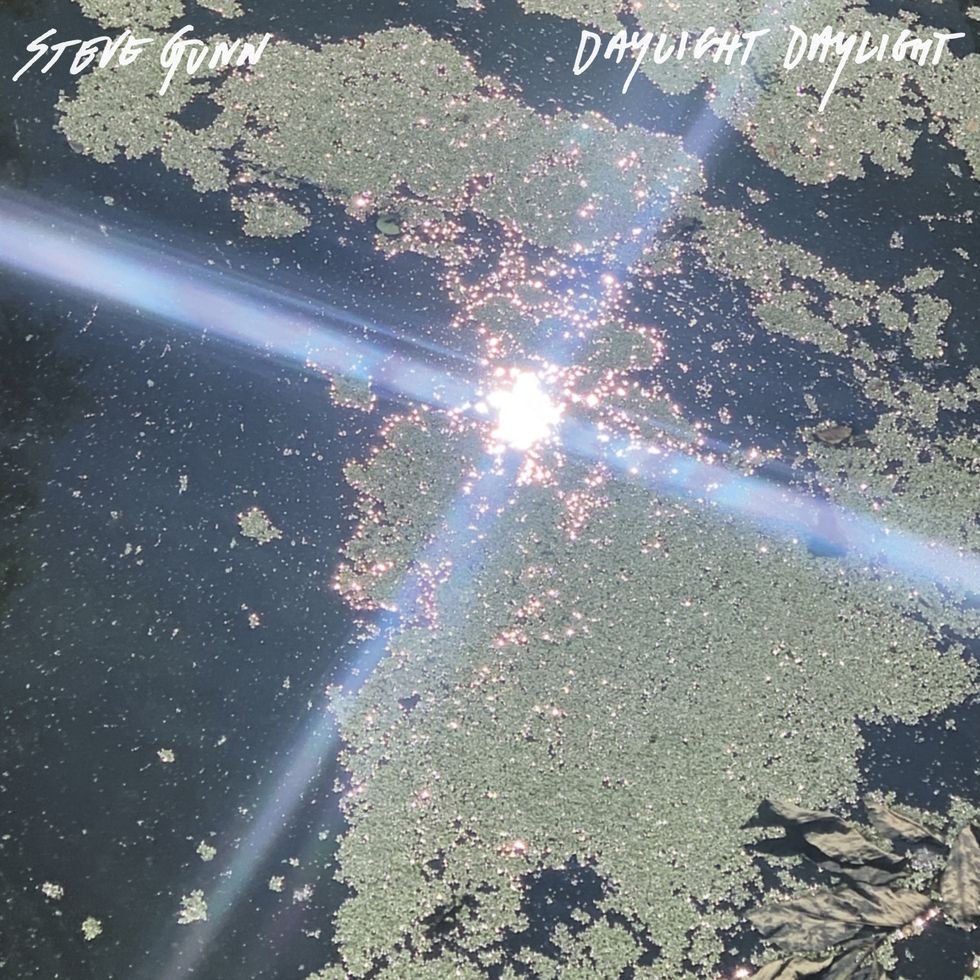
With Daylight Daylight, Gunn wanted to capture something of the intimacy of playing solo, the sense of possibility and discovery that sparks when he sits down to write, while also creating a rich sonic world for the listener to inhabit. Rather than pulling together a band to flesh the songs out, as he’s done on previous albums, he enlisted a single primary collaborator: producer James Elkington, an old friend and longtime collaborator (who also produced Gunn’s 2019 album The Unseen In Between). Elkington is known as a guitarist, but Gunn asked him to contribute arrangements of strings and woodwinds, inspired in part by the music they’ve talked about over the years (ie. Mark Hollis, Ennio Morricone, The Fall, Basil Kirchin) and the evolution of their own relationship making records - both together, and with others. They soon found a fruitful working process for Daylight Daylight: Gunn would record solo demos and send them to Elkington, who had free rein to develop the arrangements on his own. Working primarily out of Elkington’s Nada Studios in Chicago, they would continue adding from there—a whisper of a synthesizer, a guitar overdub, a muted percussion line—but they were committed to the relative spareness of their initial approach. Macie Stewart (violins and viola), Ben Whiteley (cellos), Nick Macri (upright bass) and Hunter Diamond (woodwinds) also contributed. Listen to the album opener “Nearly There” today: noquarter.lnk.to/nearlythere And pre-order Daylight Daylight at the link below: noquarter.lnk.to/daylightdaylight
Tracklisting:
Nearly There
Morning on K Road
Another Fade
Hadrian’s Wall
Daylight Daylight
Loon
A Walk
Gunn will tour the UK and Europe in October and November and is announcing a run of US dates today.
Sept 11 – Chicago, IL @ Sound & Gravity Festival
Sept 25 – Kingston, NY @ Tubby’s Oct 23 - London, UK @ St. Mathias *
Oct 24 - Glasgow, UK @ Hug and Pint *Oct 25 - York, UK @ The Band Room *Oct 26 - Shropshire, UK @ Firefly *
Oct 28 - Stockholm, Sweden @ stadsgardsterminalen
Oct 29 - Göteborg, Sweden @ Pustervik
Oct 30 - Oslo, Norway @ Bla
Oct 31 - Kristiansand, Norway @ Dirty Old TownNov 1 – Stavanger, Norway @ Folken
Nov 2 – Bergen, Norway @ Kunsthall
Nov 9 - Sétubal, Portugal @ Forum Luisa TodiNov 14 - Dranouter, Belgium @ Dranouter
Nov 15 - Turnhout, Belgium De Warande
Dec 3 – Philadelphia, PA @ Johnny Brenda’s
Dec 4 – Baltimore, MD @ Metro
Dec 5 – Raleigh, NC @ King’s
Dec 6 - Washington, DC @ DC9
Dec 10 – Portsmouth, NH @ The Press Room
Dec 11 – Portland, ME @ Space
Dec 17 – New York, NY @ Le Poisson Rouge
Jan 1 – Sawyer, MI @ Out There
Han 14 – Seattle, WA @ The Triple Door
Jan 15 – Vancouver, BC @ The Fox Cabaret
Jan 17 – Portland, OR @ Polaris Hall
Jan 20 – San Francisco, CA @ Café Du Nord
Jan 21 – Santa Cruz, CA @ The Crepe Place
Jan 22 – Ojai, CA @ Deer Lodge
Jan 23 – Los Angeles, CA @ The Lodge Room
Jan 25 – Pioneertown, CA @ Pappy’s & Harriet’s
*w/ James Elkington
Tame Impala Releases New Single “Loser”
Today, Tame Impala (Kevin Parker) unveils “Loser,” the second song of this new era. LISTEN HERE. The track continues Parker’s fearless exploration of rhythm, texture, and sonic experimentation, building on the meticulous studio approach that has defined his career. The single is accompanied by a music video directed by KRISTOFSKI, and starring actor/musician Joe Keery (Stranger Things, Fargo). Watch the clip HERE:
Prior to today’s release, Parker gave fans a taste of what’s to come with the release of his sprawling, drum-beat heavy “End of Summer.” It drew listeners back to the acid house summer of ’89, free parties of the mid-90s, and Australia’s bush doofs in outback paddocks. “Loser” continues Parker’s journey into new sonic territory, layering hypnotic rhythms and textures that push Tame Impala’s sound ever forward. Drawing from a rich history of dance music, his work transforms the imagined past into a sound that feels both present and eternal, reaffirming Tame Impala as one of modern music’s most visionary acts.
Kevin Parker has emerged as one of the most influential voices of the last decade. A singular artist renowned for carving out a distinct sound all of his own, Parker crafts transcendent genre-bending sonic landscapes playing every instrument and acting as writer, producer, mixer and engineer on his projects. He has been nominated for four GRAMMY awards with one win for his collaboration with Justice on 2024’s “Neverender.” In his home country of Australia, he’s racked up an impressive 13 ARIA Awards and 27 Nominations. He’s won the BRIT Award for Best International Band and scored nominations for two Billboard Music Awards and an American Music Award. Tame Impala has had numerous US Alternative Radio Top 10 songs including two #1’s for “Lost In Yesterday” and “Is It True.” Tame Impala’s “The Less I Know The Better” is part of the Billionaires Club with over 2 billion streams and the project has racked up numerous gold and platinum certifications globally.
Tame Impala has headlined festivals and arenas around the world and released four full length albums - InnerSpeaker, Lonerism, Currents and his most recent album The Slow Rush. The Slow Rush landed at #1 in multiple territories and was his highest charting album to date in both the US and UK, with 14 top 10 chart positions around the world. As a writer and producer Parker has collaborated with Dua Lipa, The Weeknd, SZA, Lady Gaga, Travis Scott, Mark Ronson, Gorillaz, Thundercat, Kali Uchis, 070 Shake, Rhianna, Miguel, A$AP Rocky and many more.
Jimi Hendrix Sonic Scholar Andy Aledort | 100 Guitarists Podcast
We figure Jimi Hendrix is easily the most discussed guitarist of all time. And at this point, there are probably few, if any, stones left unturned. So for our Hendrix episode of 100 Guitarists, we had to go to the ultimate scholar on Hendrix’s playing to get deep, and luckily we knew just who to call.
Whether you realize it or not, you’ve probably learned at least a song or two from a transcription or lesson by Andy Aledort. A veteran guitar journalist and transcriber whose resume stretches back to the earlier days of guitar magazines, he’s released books and DVDs teaching the secrets behind Hendrix’s playing and continues to post on YouTube. And if that’s not authoritative enough, Andy has not only played with the Band of Gypsys, but he’s one of the guitarists that Buddy Miles and Billy Cox called for the recording of their The Band of Gypsys Return record.
On this episode, Andy walks us through his own experience of Hendrix’s music, plays us some examples, and tells us some stories from the early days of guitar journalism.
Thanks to our Sponsor, Strings by Mail!
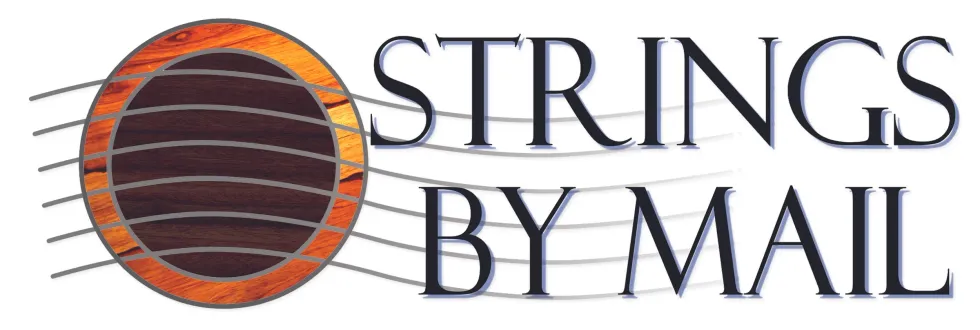
Learn More stringsbymail.com
The Red Light Trifecta
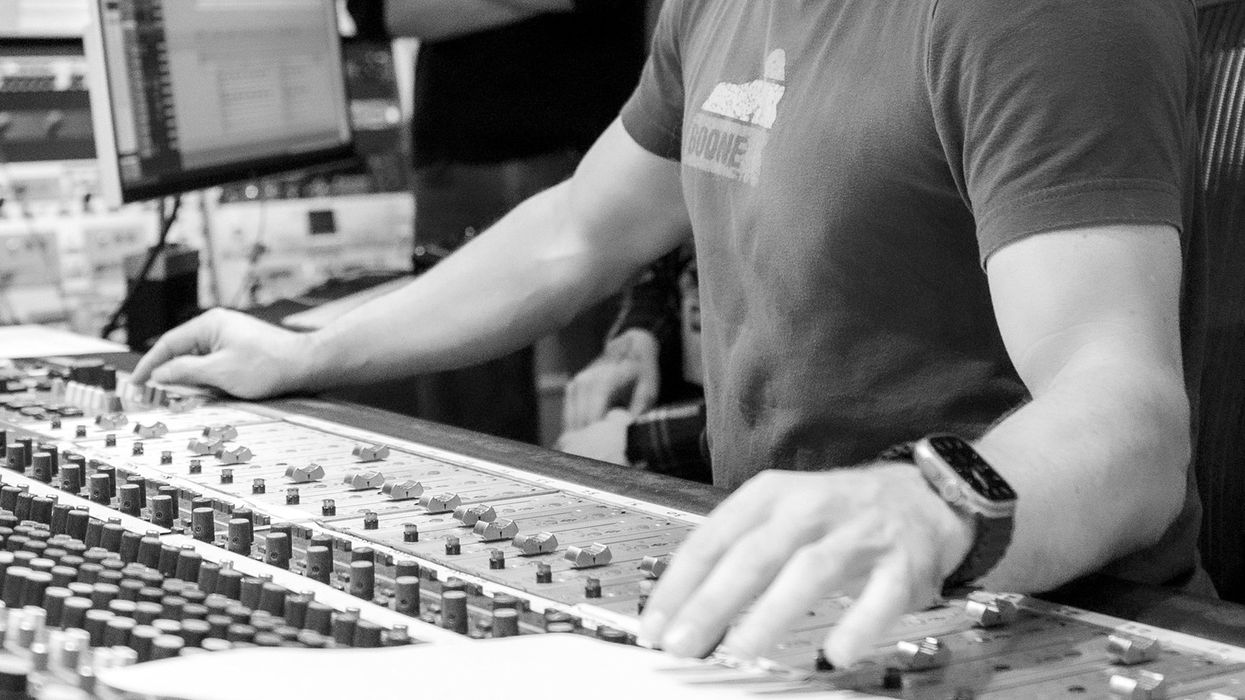
Player feel, mic placement, and your recording room are the real secrets to getting soulful, compelling performances. Spend time understanding them before you push the button.
In a world saturated with plugins, presets, and post-production wizardry, it’s easy to forget the most important part of the recording process. I call it the “Red Light Trifecta.” It’s a simple, powerful concept that can transform your recordings from sterile to soulful—regardless of your gear, your room, or your budget. Tighten up your belts, the dojo is now open.
The Red Light Trifecta refers to three interdependent elements that define every recorded sound: the player (of which the instrument is merely an extension), the microphone (and its placement), and the room. If you’re lacking in any one of these, your recording suffers—not just in fidelity, but in feel. When all three work in harmony, the red light on your recorder becomes a doorway to magic. Below, we’ll explore the steps to achieving this.
1. Feel First, Gear Second
It’s easy to get lost in the gear conversation. The internet is full of passionate debates about preamps, converters, boutique mics, and vintage/new guitars. But none of it matters if the performance isn’t compelling.
When you press record, you’re not capturing a tone; you’re capturing a human being’s interaction with an instrument. You’re capturing intention, emotion, and energy. The touch of a player’s fingers on the fretboard, the timing of a right-hand mute, the bend at the end of a phrase—these micro-decisions are what form the soul of a recording. And they’re specific to that player.
“When you press record, you’re not capturing a tone; you’re capturing a human being’s interaction with an instrument.”
If you’ve ever plugged into someone else’s rig—same guitar, same amp, same settings—you know how uncanny it is that you still sound like you. Conversely, a truly great player can make a pawnshop guitar sound like it came from a boutique luthier’s bench. That’s not mysticism; it’s muscle memory, control, and mindset.
So the first rule of recording is this: Start with the player (even if it’s you)! Are they connected to the music? Are they playing with purpose? No amount of EQ or compression can fake that.
2. The Mic: Placement Over Price Tag
If the player is the heart of the performance, the mic is the conduit. There are thousands of microphones out there; some with reputations so mythic they practically glow in the dark. But a great mic in the wrong place will still result in a lousy recording. Conversely, a modest mic in the right spot can yield professional, even breathtaking results.
Mic placement is where your ears matter more than your eyes. It’s about experimenting, listening, and adjusting. Moving a mic an inch can dramatically change the tone—less boom, more clarity, tighter low end, softer transients. You’re not just pointing a mic; you’re sculpting a sound at the source.
Want a quick way to test your placement? Record a short passage, then move the mic slightly and record again. Compare. Listen to not just the tone, but the space, the balance, the emotional impact. Don’t be afraid to break rules or try unconventional setups. Your job isn’t to copy someone else’s sound—it’s to find the best version of yours.
Remember: It’s very easy to make an expensive mic sound cheap. But with care, it’s also possible to make a budget mic sound exceptional.
3. The Room: The Invisible Instrument
The third member of the trifecta is the most misunderstood—and the most revealing: the room. Every space has a sound, whether you’re aware of it or not. Some spaces are flattering. Some are brutal. But all of them are recorded.
Think of the room as your invisible instrument. It contributes resonance, reflections, and tone. It shapes the reverb tail, the attack, and the decay. If the room is boomy or boxy, your track will sound that way—even before you add any processing. If it’s too dry, you might find your recordings feel lifeless or anemic.
That doesn’t mean you need a world-class studio with floating floors and golden ratios. It means you need to understand your space. Clap your hands. Walk around while playing. Record from different spots. Learn what your room wants to do naturally and work with it, not against it.
Sometimes, the best solution is to change the instrument’s location by a few feet. Or use furniture as gobos. Or hang a blanket. Or lean into the room’s quirks and let them define the character of the track.
The Trifecta in Action
When all three elements align, you get a vibe. You get a performance that resonates emotionally, and sonically. And in the end, that’s what we remember: not the mic model or plugin chain, but how the music made us feel. Until next month, namaste.
Strange Audio The Eloise Review
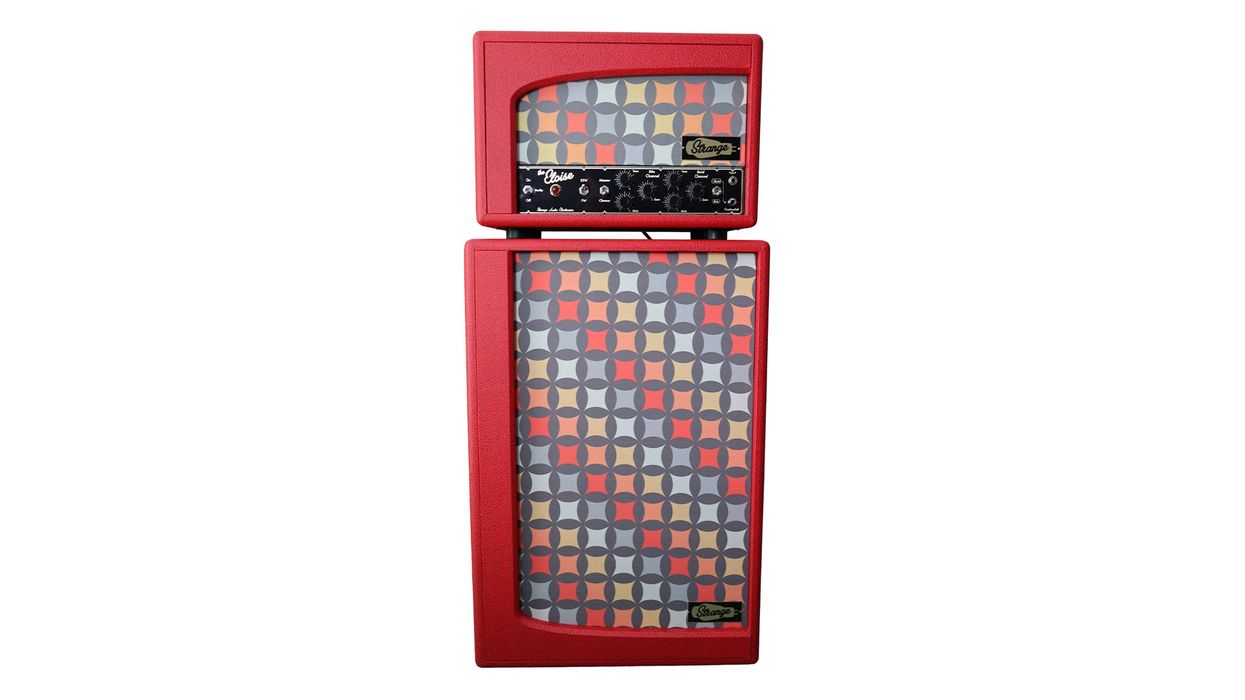
Bold aesthetics and simple but flexible controls make this extroverted 2-channel amp a star.
When it comes to aesthetics, most modern amp design has been lacking for a long time. Go way back to the middle of the 20th century, and you’ll find amps with serious flair. I’m talking about cute little vintage lap-steel combos cranked out by Valco for brands like Oahu, mid-mod-styled early-’60s Gretsches, short-lived watermelon-and-tree-bark ’50s Ampegs, and Fender’s early woody amps, which presaged the bachelor-pad era. By the mid ’60s or so, amp designs coalesced into an assortment of black boxes and have, with some exceptions, remained that way.
When Philly-area amp tech Josh Strange started building his own Strange Audio combos, their candy-colored cabs and technicolor grilles quickly caught the eyes of the Instagram set. The sheer variety of offerings, from grille-cloth options that range from floral to cloud-cover to cowboy, had some of us non-builders wondering, “Has it really been possible to make an amp look this cool all this time!?”
Strange’s latest, The Eloise, comes in a head-and-cab form factor that is stunning. More importantly, Strange’s knack for design goes well beyond the visual. The Eloise’s original circuit design, with switchable preamp tubes and a unique EQ, meets the demands of both players who want a straightforward plug-and-play amp and those who need to capture a wide range of styles or prefer a pedal platform scenario.
Outside the Box
The 35-watt Eloise head is eye-catching for its red vinyl covering and multi-colored starburst grille-cloth, but also for its more subtle but still noticeable control set. There are a pair of triangularly arranged control sets for the bite and bold channels, each of which include tone, gain, and mid knobs. The channels are selectable via a switch on the panel or a footswitch. There’s also an attenuator that brings the power down to about 7 watts, and a 3-way meaner/cleaner/both switch.
The Eloise is ruggedly constructed using top-notch components, including Soursound transformers, and capacitors from Jupiter, Vishay, and F&T. Strange offers matching cabs in 2x12 and 2x10 configurations. I demoed the 2x12, which was loaded with a pair of Weber Legacy Series ceramic speakers.
A pair of 6L6s power the fixed bias circuit, and there’s a GZ34 tube rectifier. Channel switching determines preamp tubes, however. The bold channel uses an octal 6SL7, delivering a robust voice with deep lows, warm mids, and rounded highs. The bite channel utilizes a 12AX7 for a brighter, more cutting high-mid voice. Within each channel, there’s a wide range of tones to explore via the tone control and a unique mid control. The tone knob controls high/low balance, while the mid knob sweeps the midrange voice from scooped to boosted.
Boosted and Balanced
Within each channel, the tone, mid, and volume controls work in conversation with each other, not unlike the tone and volume controls in a tweed Fender, which balance lows, highs, and mids, but also push the circuit to a saturated, overdriven state. As such, I spent lots of time with all three controls pretty near to full-on, manipulating the amp with my guitar volume or playing dynamics.
The meaner/cleaner/middle switch fine tunes output by adding or subtracting negative feedback and a preamp stage bypass cap. Cleaner selects negative feedback with no bypass cap, offering the most headroom; middle offers a medium amount of gain with neither negative feedback nor the bypass cap; and meaner has the least headroom and delivers the most overdrive by adding the bypass cap.
Between these options, the voicing of each channel, and the versatility of each channel’s controls, I dialed up a very wide range of tones. I could find saturated, cutting lead sounds using the bite channel in meaner mode and cranking all three controls, or throaty, neck-pickup tones with the bold channel in cleaner mode, the mids in the upper range, and the gain pulled back to about 60 percent.
Since The Eloise is a cool 35 watts, the natural overdrive is loud enough to hang alongside a rock rhythm section, but not so loud that you’ll get kicked out of the band. And there’s enough headroom that The Eloise can serve as a pedal platform and deliver effect-driven distorted and fuzz tones. The attenuator is effective, too, for keeping overdriven tones ripping without sacrificing tone at lower levels.
The Verdict
The look of The Eloise—and the entire Strange Audio line—helps set a high bar for amp style, and hopefully more builders will take note. Its unique control set and approach to channel voicing is compelling, and the interactivity between the controls gives it a wide range of tone options that are fun and intuitive to explore.
At 35 watts, The Eloise hits a sweet spot for those who want to push their amp while keeping volume manageable. Ultimately, Strange strikes a nice balance between familiar 6L6 territory and a novel approach to how to widen the sonic playing field.
New Flat Patch Cables Join Gator Cableworks’ Composer Series
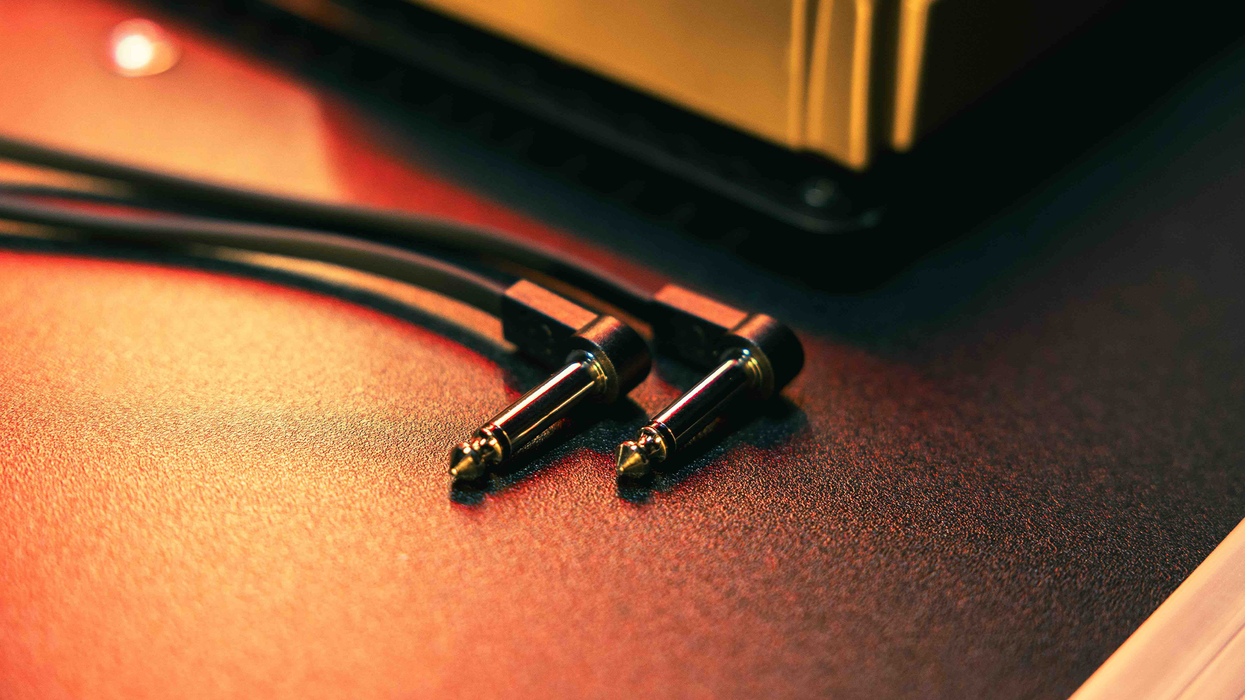
Tight spacing between pedals calls for a tighter cable approach. Gator Cableworks now offers a space-saving option with the launch of Flat Patch Cables, available as part of its Composer Series collection of high-quality audio cables.
The Composer Series Flat Patch Cables are built for musicians who demand premium signal integrity and efficient pedalboard management. Each cable features slim, compact connectors that fit into tight spaces and adapt to a variety of challenging pedal layouts, helping reduce clutter and maximize usable surface area on crowded boards.
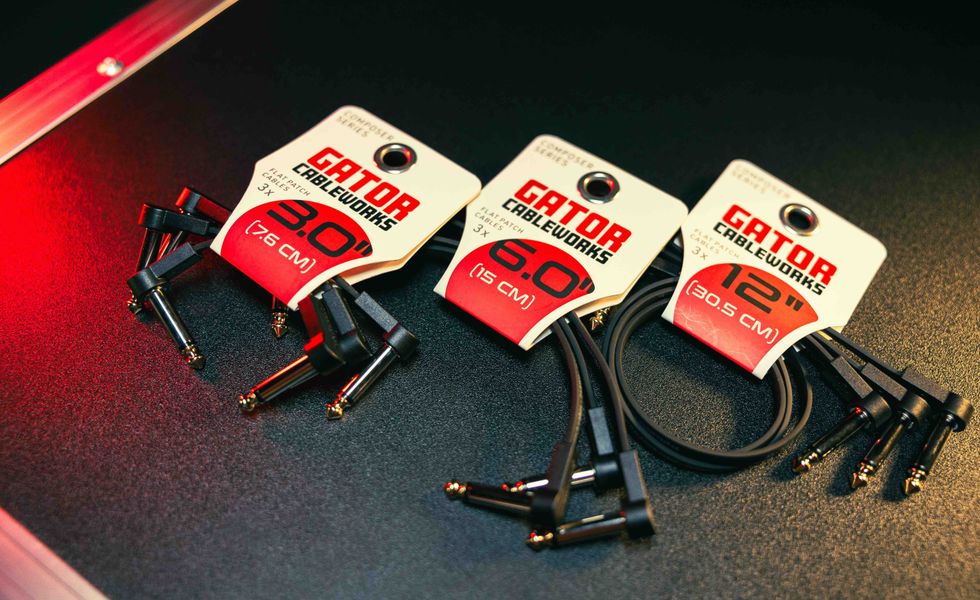
Engineered for high performance, the cables feature 99.99% oxygen-free copper conductors to ensure clear signal transmission. The 24 AWG low capacitance construction helps preserve tone while minimizing interference, and a double-shielding layer delivers a 100% shielding factor to guard against noise and RF disruption.
Each cable includes TS male right-angle ¼-inch connectors with nickel-plated housing and 24K gold-plated contact tips, providing optimal conductivity and corrosion resistance for long-term reliability.
The Composer Series Flat Patch Cables are available in the following sizes and pack options: 3-inch, 6-inch, 12-inch and 24-inch lengths, as well as 3-packs of 3-inch, 6-inch and 12-inch models. All Cableworks cables are backed by a Limited Lifetime Guarantee.
For more information, please visit www.gatorco.com.
5 Steps to Better Hybrid Picking
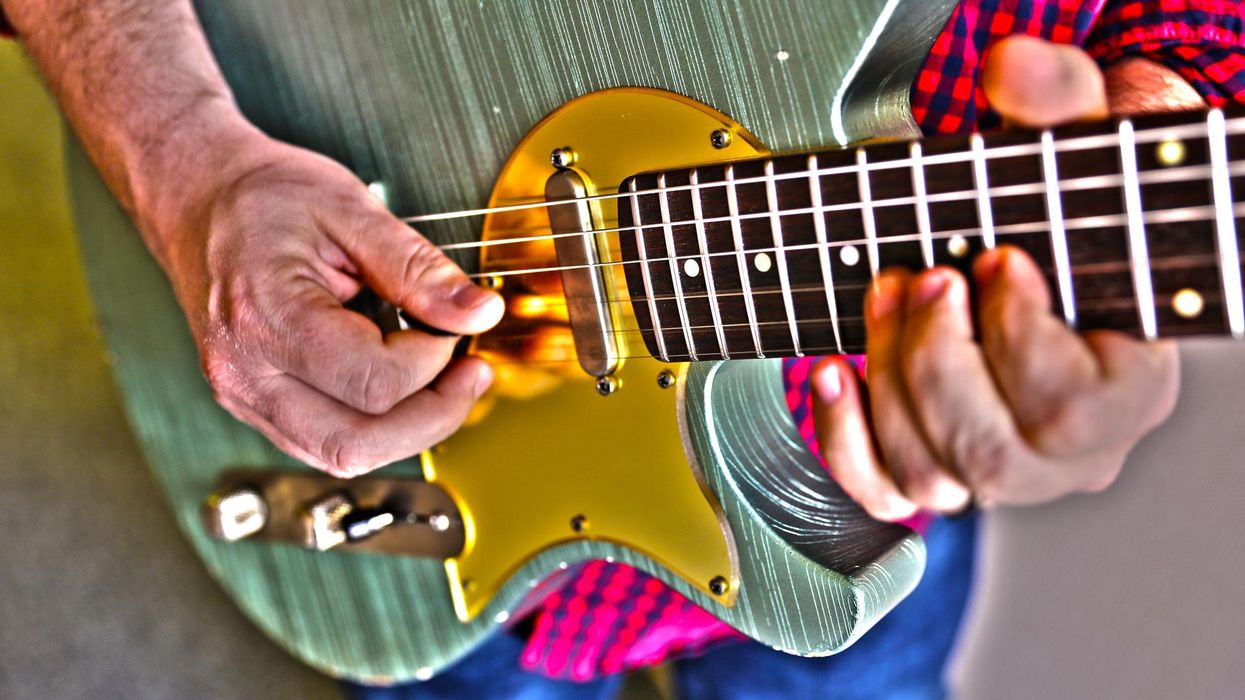
The first thing most guitarists think of when they hear the phrase “hybrid picking” is undoubtedly twangy Telecasters. While that may be the most common use of hybrid picking, it is far from the only application. Diving into hybrid picking opens a whole new world of control, timbre possibilities, ideas, speed, and more.
As beginning guitarists start to move into the intermediate level, they typically build speed by practicing alternate or economy picking. It makes complete sense–especially to someone who’s new to the journey–that if you’re holding a pick, that’s what you should strike the strings with. I grew up learning how to play taking a slightly different route. Personally, I found it easier to be faster–and cleaner–to hybrid pick phrases, lines, and solos. It clicked with me and therefore was the technique I homed in on when growing from a beginner to an intermediate player. My alternate and economy techniques still aren’t as comfortable as hybrid picking, so here are some ideas from a guy that learned things from a bit of a different perspective. If you feel like your playing has plateaued, this might help you to keep climbing.
Small note: I use the pad of my fingers when hybrid picking and not the nail.
Step 1: Focus on the Small Differences
In Ex. 1 you’ll find what I consider to be one of the main benefits of getting comfortable with hybrid picking. I pick every note of the phrase on the first pass, but hybrid pick it on the second. On the second pass, the root note (open 4th string) is the only note the pick hits. I generally like to approach hybrid picking with an “each finger is assigned a string” method, meaning in this example the middle finger picks the note on the 3rd string and the ring finger picks the note on the 2nd string. Listening to the same two phrases played differently, you’ll note that there’s a tad more feel and nuance the second time through. These are subtle but can make all the difference in the world when it comes to creating, playing, recording, or performing parts. The combination of a mountain’s worth of small differences like this are what sets the pros apart!
Step 2: How to Play Chords with Hybrid Picking
Ex. 2 is how I love to use hybrid picking when comping. In this example the pick is handling everything on the 5th string while the middle finger picks the 4th string, the ring finger picks the 3rd string, and the pinky picks the 2nd string. Not only does hybrid picking this groove allow for a ton of control, it allows the pick to rhythmically separate from the rest of the fingers, creating a faux bassline. Again, using the middle, ring, and pinky fingers give a softer touch to the upper end of the chords, creating a more nuanced feel.
Step 3: Time to Go Low
Taking the idea of the pick handling the low end of the chords and giving the notes focus while the fingers contribute to clarity and softness on the upper end of the chords, we get Ex. 3. The pick only strikes the 6th string, while the middle finger picks the 3rd string, and the ring finger picks the 2nd string. This example of hybrid picking is widely used by guys like John Mayer and allows a player to have a ridiculous amount of control over what strings are being struck when playing something clean such as this.
Step 4: Let’s Get Sweeping
Applying this concept to lead playing, Ex. 4 replaces what would typically be an upward sweep with hybrid picking. The pick strikes the A note on the 7th fret of the 4th string. Then, the middle finger picks the C# on the 6th fret of the 3rd string, the ring finger picks the E note on the 5th fret of the 2nd string, and the pick strikes the F# on the 7th fret of the 2nd string. This is followed by a downward sweep of the same notes in reverse order. To end the lick, I pick the open 4th string. That’s when hybrid picking allows me to play a rolled Dmaj7 chord. These two embellishments are highly useful when both soloing and comping, and once again are a small touch that provides some “spice.”
Step 5: Enough with the Clean Stuff
Ex. 5 is a lick I use (I should probably say abuse) consistently. My sweep picking skills are abysmal. In part because I haven’t dedicated the appropriate time to practice them, but also partly because I tend to hybrid pick as a cheat or workaround. The lick is based on a G major arpeggio beginning at the 10th fret of the 5th string. I then pick the 4th string with my middle finger and the 3rd string with my ring finger. From there, I gather for a few notes with the pick on the 3rd string and repeat the pattern again across the fretboard. However, the second hybrid-picked part of the lick begins by striking the 9th fret of the 3rd string with the pick, then using my middle finger to pick the 8th fret of the 2nd string and my ring finger to pick the 7th fret of the 1st string. To end the arpeggio, I strike the 10th fret of the 1st string with the pick. The last bit of the phrase is a garden variety blues lick ending.
Hybrid picking is an extremely valuable tool that I think every guitar player should have in their arsenal. A player can have more control, feel, and timbral options compared to only using a plectrum, and it’s an easier way to add velocity with very minimal right-hand movement or tension. Try hybrid picking different grooves, licks, arpeggiated chord shapes, and even pieces of lead lines you already know to begin exploring how the technique can work for you.
Mr. Black Creates a Powerful Analog Time-Modulator
Continuing to shatter the boundaries of what is possible within the analog time-modulation domain, Mr. Black is proud to announce the all-new Mod.One - Analog Modulator. The Mod.One combines chorus, flanger and “high-band” flanger into a single compact pedal, readily capable of creating each effect independently, and further expanded by its ability to seamlessly morph between these processes on the fly, bridging the gaps between the classic, related modulation sounds, while affording all-new tones and possibilities.
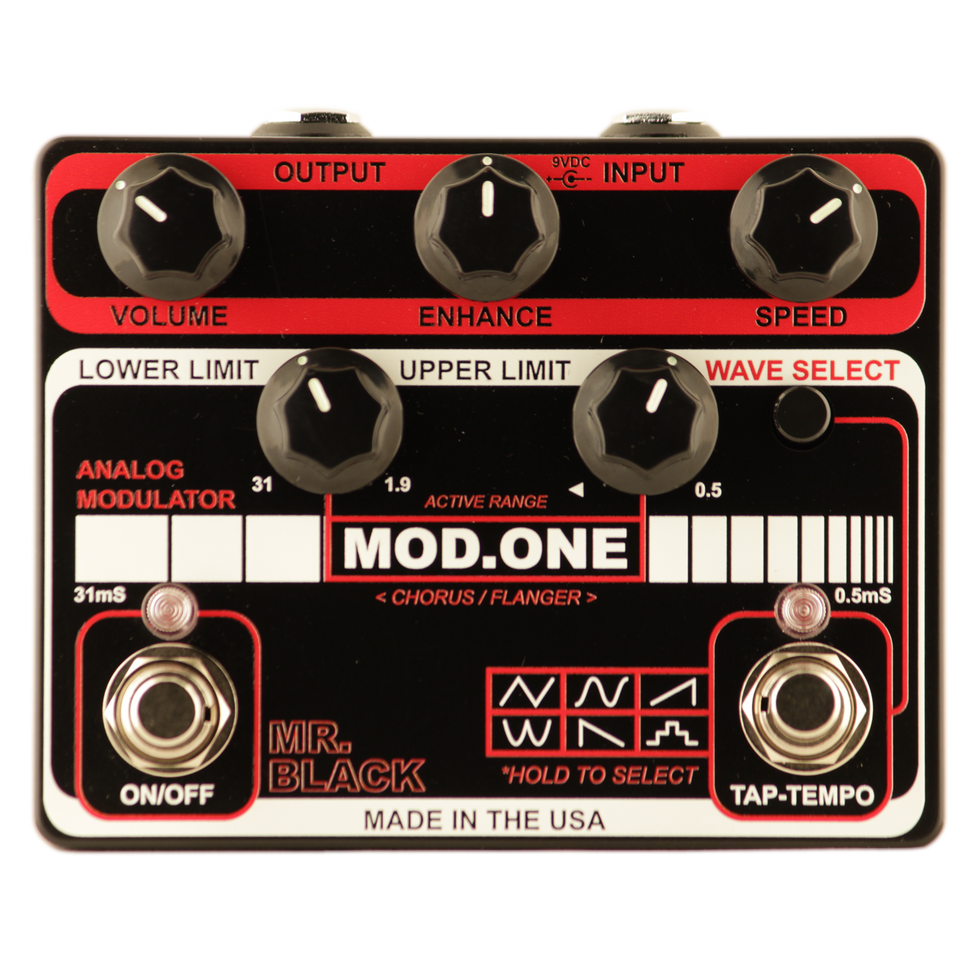
Hand built and individually calibrated, the Mod.One also includes Click-Less relay true-bypass, six waveforms and precision tap-tempo, delivering premium analog modulation in a built-to-last compact and handsome package.
Key features:
• 100% analog signal path
• Wide range of LFO speeds
• Six waveforms
• Tap-Tempo
• Click-Less True-Bypass
• Powered by “Industry Standard” 9VDC
The Mod.One carries a MAP of $249.95 and is handmade, one-at-a-time in Portland, Oregon U.S.A. Available at: www.mrblackpedals.com and retailers worldwide.
Hammer Time: How a New Tool Is Changing How Luthiers Understand Tonewood

Over the past few decades, I’ve devoted much of my lutherie career to understanding musical-grade tonewoods and the instruments that they become. While some builders seem to assess wood instinctively, I’ve always needed real, solid data—something concrete to show how a material behaves and how to best use it. That meant diving deep into the science: analyzing frequency, weight, and stiffness to understand how, and why, these characteristics shape an instrument’s sound.
One of the most powerful tools for this kind of work is the FFT (Fast Fourier Transform) analyzer, which lets you track and study anything that vibrates or makes sound. When testing tonewoods or working on guitars, FFT analysis is indispensable. Over the years, I tried a variety of FFT systems, but eventually adopted SpectraPlus by Pioneer Hill Software. It elevated my analysis to a whole new level. Even mobile FFT apps, though a bit quirky at times, have their place. I’ve had one on my phone for over 15 years. They’re a great entry point for players and curious minds alike.
In 2024, a major breakthrough occurred: the launch of the Acousonix Sonic Hammer, which I helped develop. This handheld device detects and displays the primary resonant frequencies of almost anything you tap. For tonewoods, it reveals key modal frequencies that help gauge a piece of wood’s acoustic potential. For guitars, it’s both insightful and fun: You can tap the top to measure its resonance, hold it near the soundhole to detect air resonance, or tap the back to read the back plate’s voice. Together, these readings paint a clearer picture of the instrument’s tonal fingerprint.
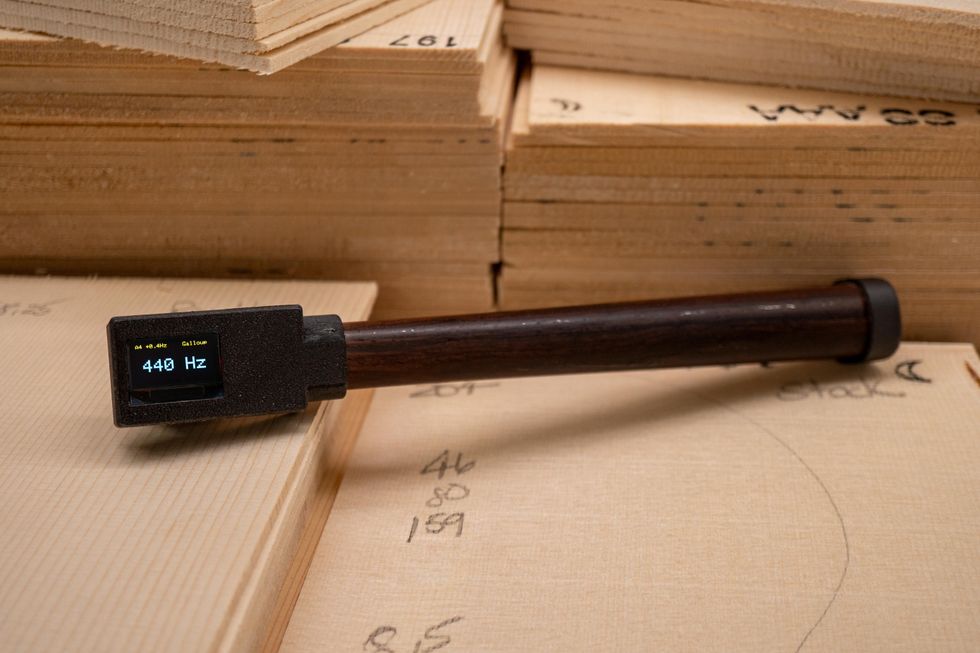
Say you’re comparing two guitars: One feels more “alive,” but you can’t explain why. By sampling each guitar you’ll likely see frequency differences tied to weight, tension, and structural behavior. That kind of information can help guide buying decisions, repair work, or just satisfy your curiosity.
Although we originally developed the Sonic Hammer for tonewood analysis, its applications have since expanded. With smart software updates and continued experimentation, we’ve used it to fine-tune banjo heads, drums, archtop guitars, and even ukuleles. Today, it’s being used in studios, repair shops, manufacturing facilities, and by tonewood sawyers to help improve yield, quality control, and efficiency.
It’s no surprise that everyday players, collectors, and music shops have embraced the hammer, not just for smarter purchases, but to better understand their instruments, inventories, and collections. Once a guitar’s sonic footprint is captured, you can track it over time. Whether it’s aging, humidity, or environmental shifts, this tool provides a simple way to monitor and preserve an instrument’s acoustic health. In recording studios or on the road, if an instrument is problematic, the hammer helps engineers and guitar techs zero in on where the problem may lie. While broader implications are still unfolding, the technology is already proving both rewarding and, yes, a little disruptive. But in time, this kind of data will likely become standard in the industry.
“This handheld device detects and displays the primary resonant frequencies of almost anything you tap.”
The Founders Edition focused on detecting primary resonances, but what’s coming next is even more exciting: deeper analysis of voicing, damping, and admittance, plus built-in Bluetooth for integration with more advanced systems. Most importantly, this tool can support something I’ve long believed in: responsible tonewood use. If we want to conserve the world’s most valuable musical materials, we need smarter ways to measure and manage them. I believe the Sonic Hammer can play a meaningful role in that effort.
For guitar makers and players, we’re living in a truly exciting era. For years, I said, “This is going to take off,” and every couple of years it felt just around the corner. But during the COVID shutdown, something changed. People had time to explore, to experiment, and the science of acoustics started to catch fire. These are exciting times indeed.
For more info, visit acousonix.com.
DiMarzio Launches Colossal™ Neck & Bridge Pickups for 5-String Bass
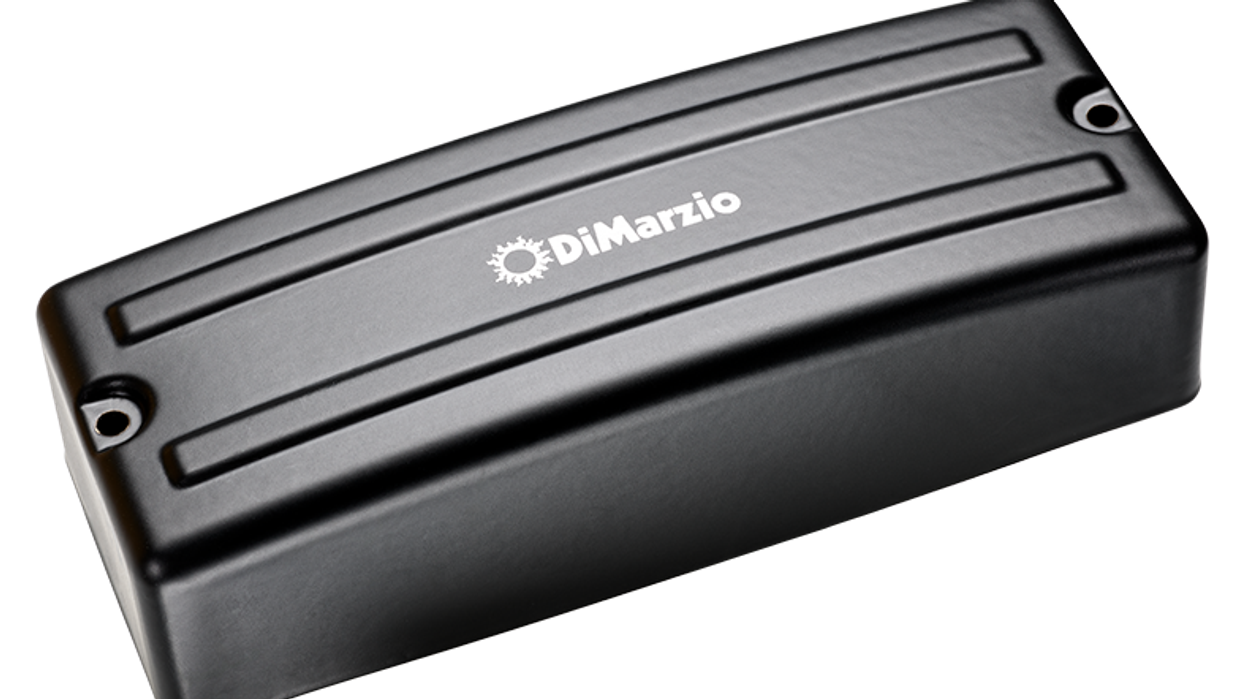
Living up to its name, “Colossal,” this pickup set has more of everything. Play them softly and they deliver an unmatched airiness to the notes; play them aggressively and they will blow your hair back. These passive pickups are designed to effortlessly respond to soft touch, slap, or aggressive pick attack with ease.
As with our game changing Relentless™ pickups, we removed all the hard edges from the metal covers, and added an arch to the top contour, bringing the sensing coils closer to the middle strings. These improvements increase the string balance and overall dynamic range.
The Colossal™ pickups are a fully humbucking design and are completely shielded, making them a better choice for both recording and live shows. These pickups can be used with the coils in series, parallel, or split configurations, making multiple sounds easily achievable without the need for digital filters. The Colossal™ Bridge and Neck can easily be combined with active electronics.
Using a thick .09375” circuit board baseplate as the foundation, the Colossal™ pickups are simple to install and use our quick connect cable system. The soapbar shaped (EMG40® sized, 37.75mm x 101.25mm) pickups incorporate Neodymium magnets, producing significantly more output and dynamic range than traditional active or passive pickups.
To improve the balance when both pickups are used together, we made the bridge position pickup louder than the neck position pickup. When the pickups are blended, you get a better volume match.
Colossal™ pickups have a richly detailed mid-range that growls, delivering notes with definition and openness, and they work well with dropped tunings. The highs are present and precise without harshness, and the lows are thunderous and tight, like the footsteps of a giant.
Available in Nickel, Gold, or Matte Black finishes.
Linkin Park Rig Rundown
Linkin Park went on hiatus for seven years after lead vocalist Chester Bennington’s death in 2017, but last September, the band announced that they were returning with new music and a new lineup—including vocalist Emily Armstrong and drummer Colin Brittain. A new album, From Zero, was released in November 2024, followed by the single “Up From the Bottom” earlier this year, and this summer, the band tore off on an international arena and stadium comeback tour. Founding lead guitarist Brad Delson is still a creative member of the band, but has elected to step back from touring. And so on the road, Alex Feder takes his place alongside founding guitarist/vocalist/keyboardist Mike Shinoda, DJ Joe Hahn, and bassist Dave Farrell.
PG’s Chris Kies headed to downtown Nashville’s Bridgestone Arena to meet up with Mike Shinoda, plus techs Mark, Ben, and Tracy, to learn how the band pulled off their much-anticipated gigs this year.
[Brought to you by D’Addario.]
Boredom Beater
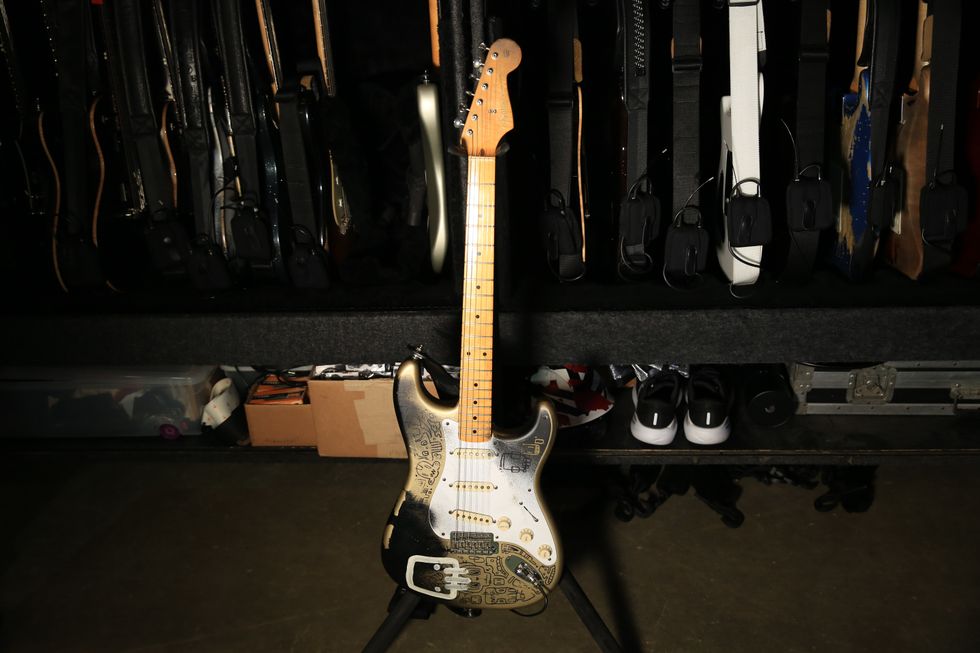
This is Shinoda’s “workhorse” Strat, a longtime trusted pal that’s featured on songs like “What I’ve Done.” There have been plenty of times when Shinoda gets bored on tour, and at one point, he started painting his guitars to keep himself occupied—including this Strat.
Painted PRS
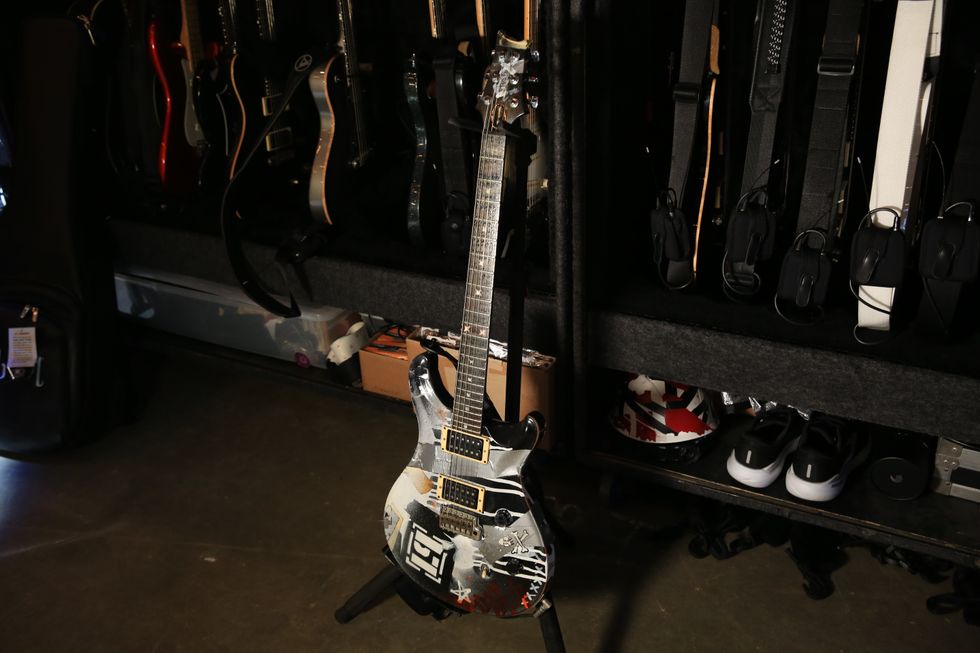
This PRS is from the band’s Meteora-era, a definitive instrument in the early years of the band. Again, the guitar’s aesthetic customizations were executed by Shinoda himself, with ink markers, spray paint, and a paint pen—plus some custom “etchings” on the fretboard. This and his other guitars are outfitted with custom Kill Spencer straps.
Blackout
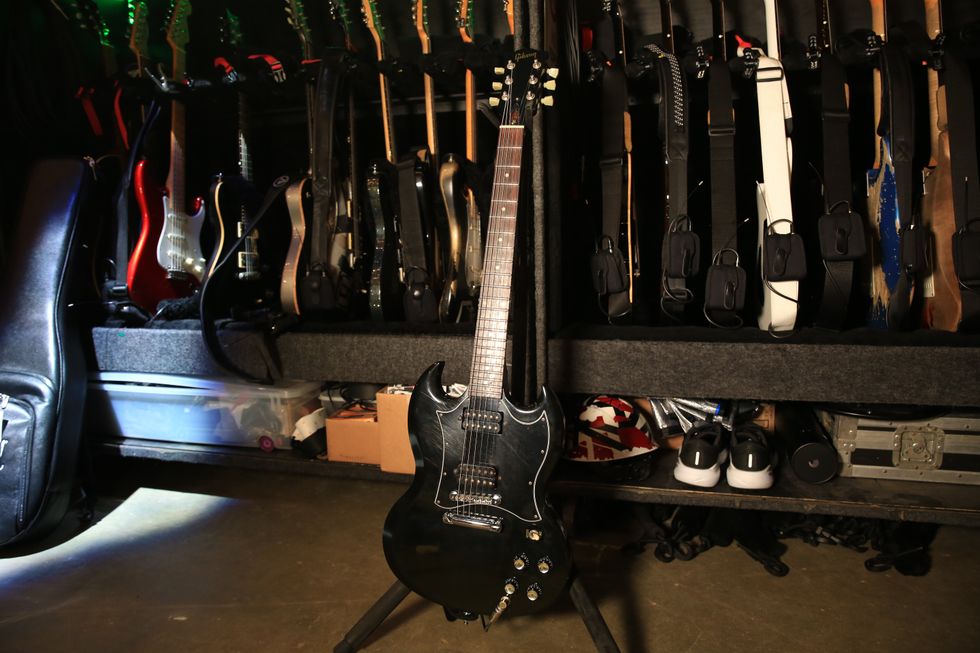
This black Gibson SG came into the picture around Linkin Park’s third record, 2007’s Minutes to Midnight.
Empty Spaces
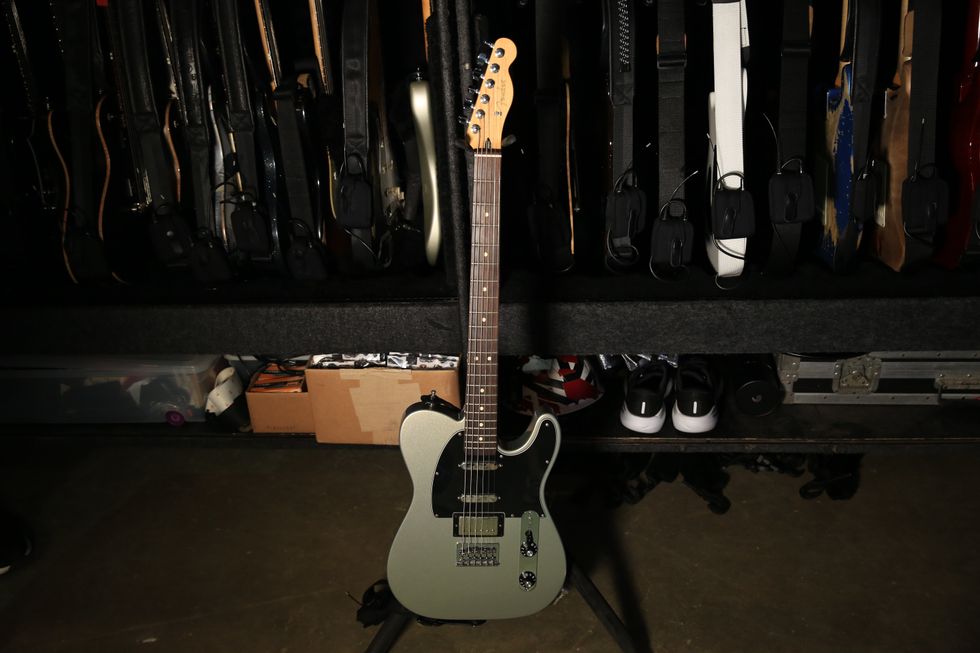
With new vocalist Armstrong’s voice filling a different spot in the band’s sound, Shinoda has adjusted some of his tunings and playing. This Fender Blacktop Baritone Telecaster helps give Armstrong’s voice space and keeps everyone in their sweet spots, frequency-wise.
Hybrid Theory Heavy
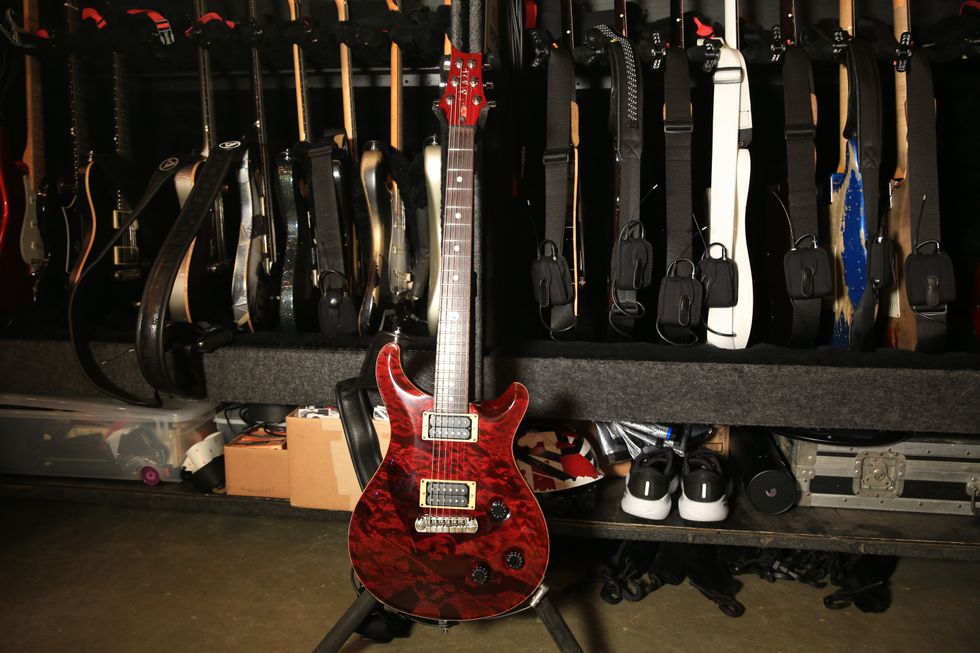
This 2008 PRS Custom 24 is a replica of Delson’s Hybrid Theory-era PRS, and sports Paul Reed Smith’s autograph on the back. It lives in drop C-sharp tuning, and if Delson is playing it, it’s loaded with D’Addario NYXLs (.010-.052). When Feder’s at the wheel, he goes for heavier top strings mixed with Delson’s packs, for a gauge range of .054-.044-.032-.017-.013-.010.
Another PRS, finished in grey and tuned to drop D sharp, features the Minutes to Midnight logo and gets brought out for “One Step Closer.” A sunburst PRS DC3 is equipped with even heavier strings for a drop A tuning: A-E-A-D-G-B.
’61 Standard
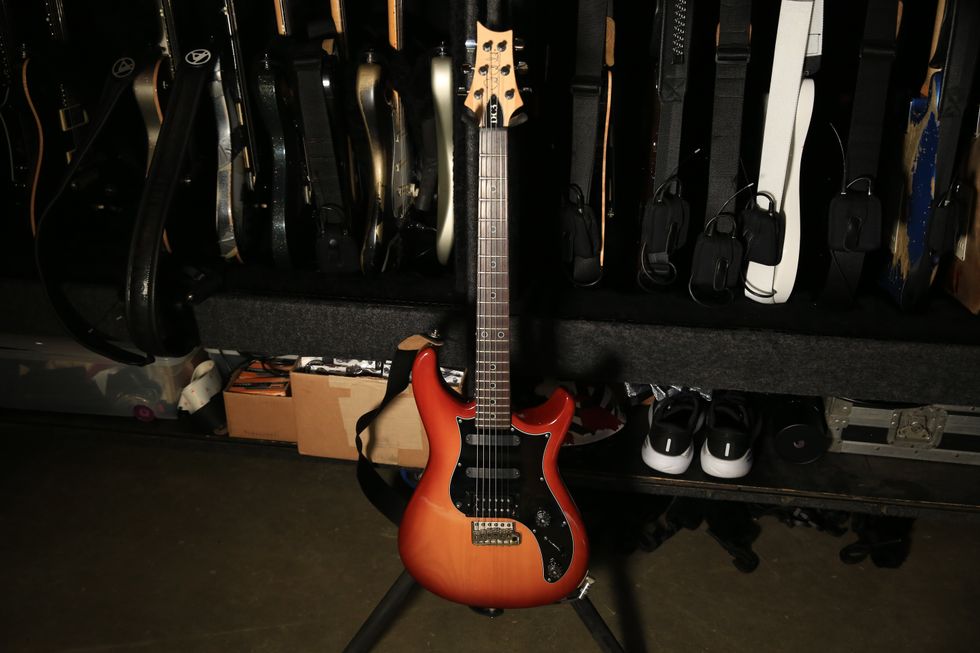
This Fender Custom Shop Rory Gallagher Stratocaster has become a staple of the live show. It’s part of a set of three that were created for Delson, designed and relic’d to mimic a 1961 Standard Stratocaster. It stays in drop D, with Delson’s standard .010-.052 strings. He uses .72mm Dunlop picks, while Feder uses slightly heavier .88mm picks.
Mike Shinoda, Brad Delson, and Alex Feder’s Rack Systems
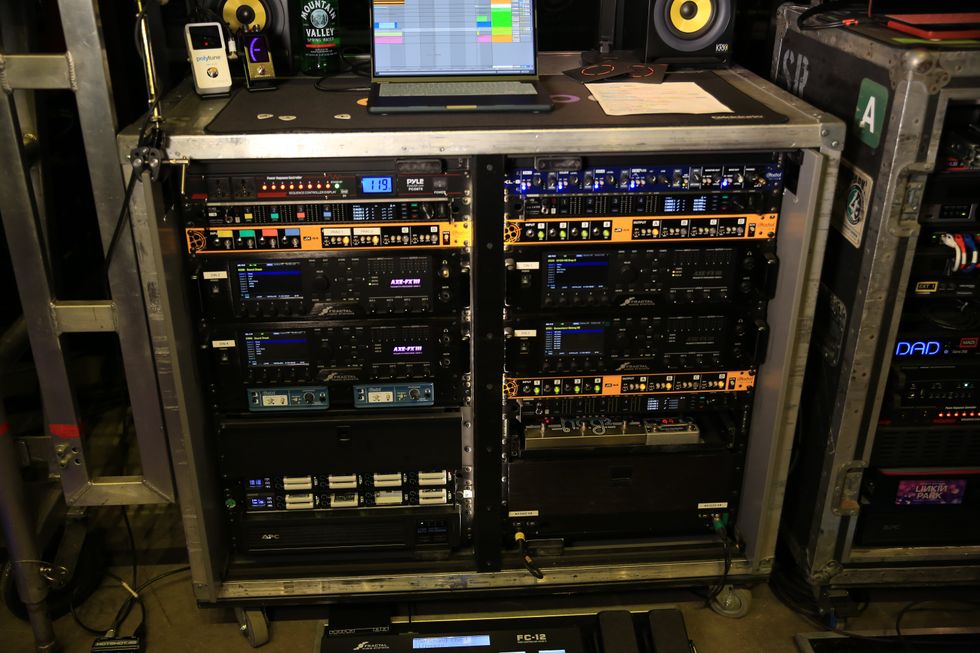
Delson’s rig (used by touring member Alex Feder) lives on the left side of this rack, while Shinoda’s takes up the right. They both include a Radial KL-8, two Radial JX44s, two Shure AD4Qs, and two Fractal Axe-Fx III units. Shinoda’s setup also includes two Electro-Harmonix HOG2 pedals. The fractals use IRs that were captured by old FOH engineer Pooch, using a Randall cabinet.
MIDI handles all of the changes for the show, though there’s a Fractal FC-12 foot controller on hand in case of emergency for manual switching. Fred Carlton of Nerdmatics, who built the Linkin Park rig for this 2024-2025 run promoting From Zero, shared some more information with us after filming: “The backline gear consists of about 11 computers running Ableton, all receiving locator information from the main playback computers. We maintain redundant computer systems for Joe Hahn’s DJ rig, Mike Shinoda’s keyboard rig, the Audio FX rig, and the Playback system. Single-computer setups are used for both guitar rigs and the bass rig, as these stations only send MIDI patch changes and do not handle audio. Additional single-computer systems are in place at Monitor World, FOH, and within the Visual department.
Each station carries an updated timeline of the show, allowing techs to insert automation data such as MIDI or timecode to control their systems. Once changes are made to the main Ableton session, we distribute updated .ALS files to all departments, enabling them to integrate their specific data into the new timeline. This workflow allows us to implement changes quickly while keeping all departments aligned. Having separate computers also gives each tech the ability to test their own system independently. In the event of losing RTP network connectivity, they can punt the show locally without relying on external automation.”
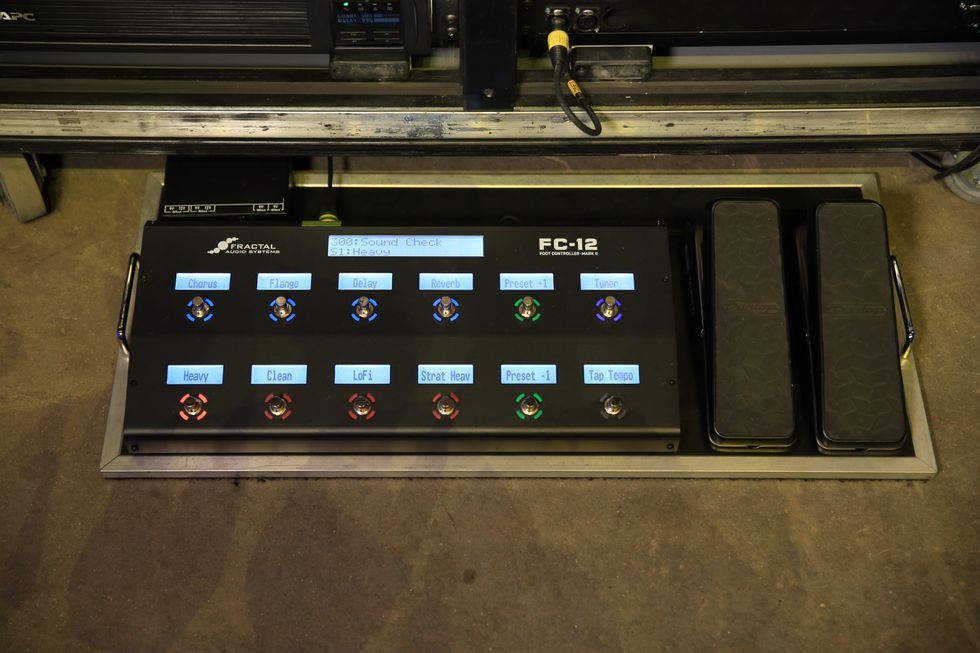
Sharpened with Precision
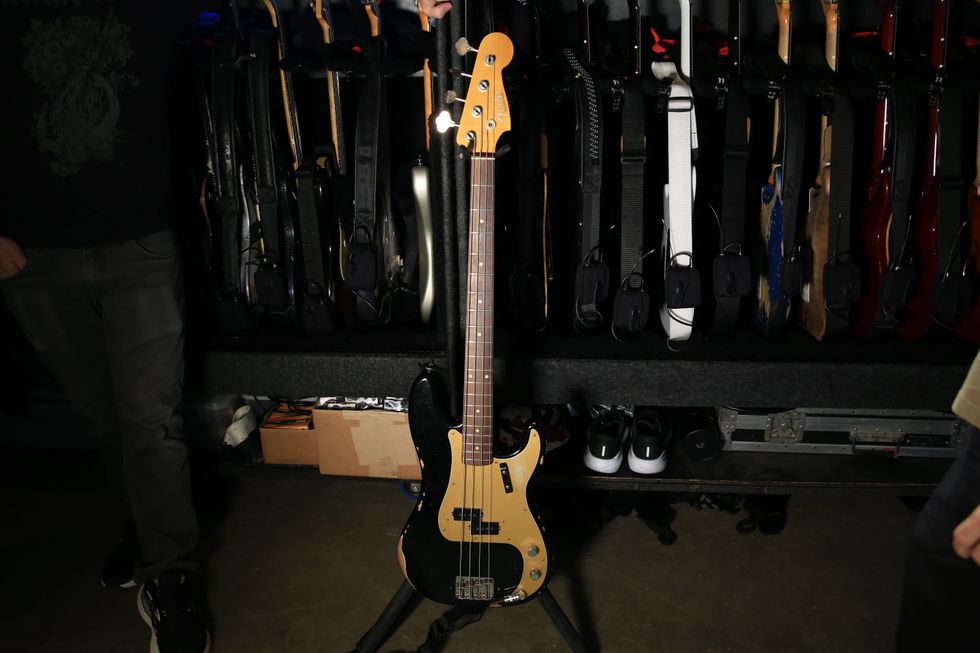
This Fender Custom Shop Precision bass is Dave Farrell’s go-to, his tech Tracy explains. It’s tuned to either drop D or standard, and Farrell uses Ernie Ball Bass Hybrid Slinky strings (.045-.105) with Dunlop .88mm picks.
Ernie Ball Basher
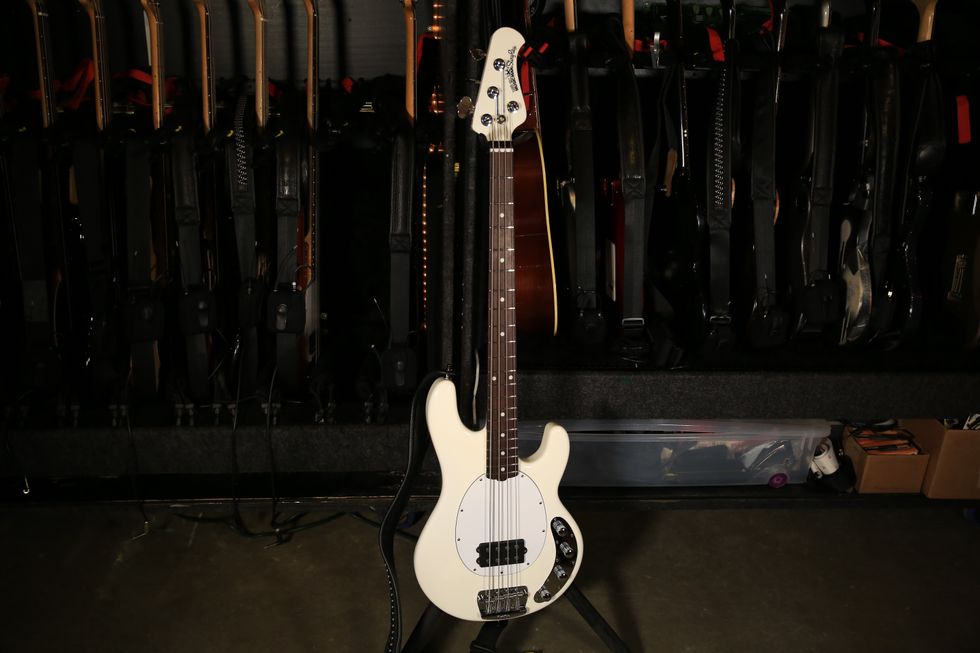
This beloved Ernie Ball Music Man StringRay, with active electronics and neck-through construction, is the second-most used bass in the rack, and comes out for hits like “Papercut” and “In the End.” It’s tuned to drop C-sharp.
Mum Knows Best
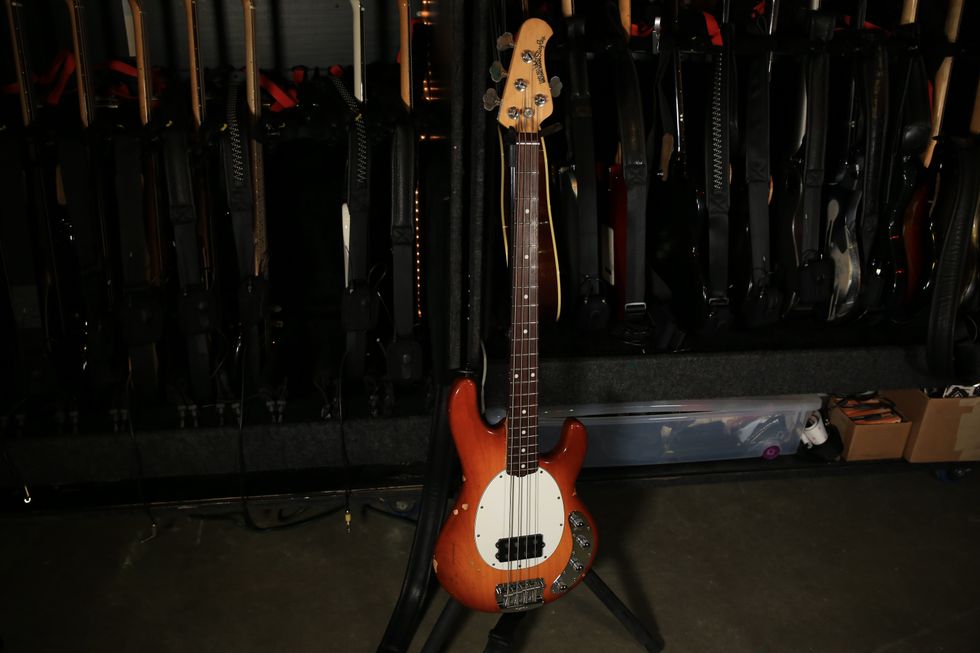
Though his other StingRay gets more play, this is the original item, which Farrell’s mother bought for him. It gets tapped for tracks “Somewhere I Belong” and “Faint.”
Dave Farrell’s Rack
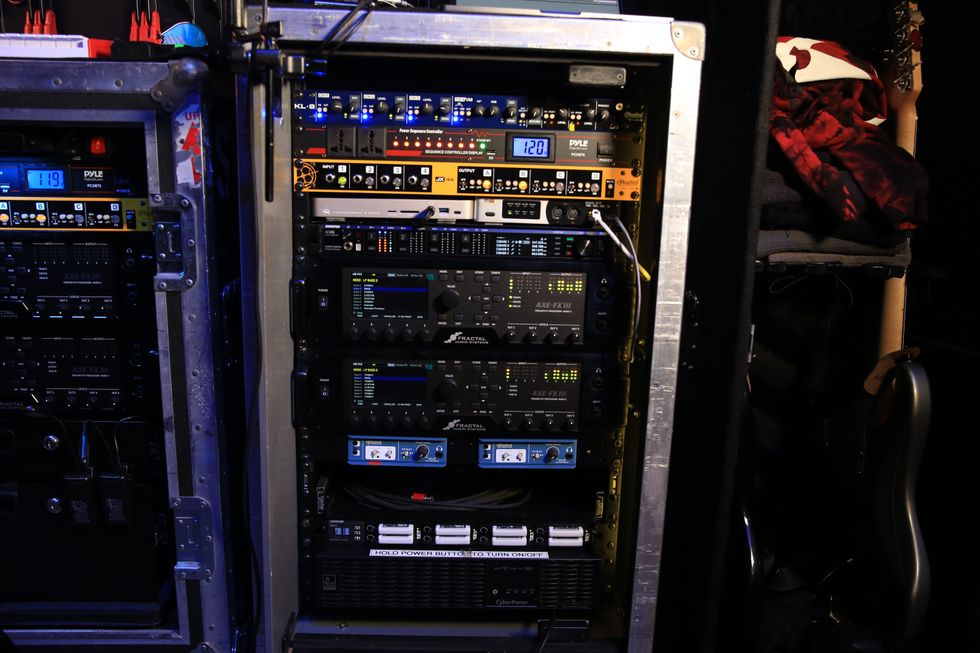
Along with the same accoutrements (Radial KL 8 and JX 44, Shure AD4Q), Farrell also uses a pair of Fractal Axe-Fx IIIs, and runs three signals—one of an Ampeg SVT model, a Marshall JMP-1 model, and a clean direct signal, run through emulations of two Ampeg 4x10 speaker cabinets—to front of house, which can mix and match between the three as needed.

Fender Custom Shop Rory Gallagher Stratocaster
Fender Custom Shop Precision bass
Ernie Ball Bass Hybrid Slinky Strings (.045-.105)
Band Industries Launches Roadie 4 Automatic Guitar Tuner
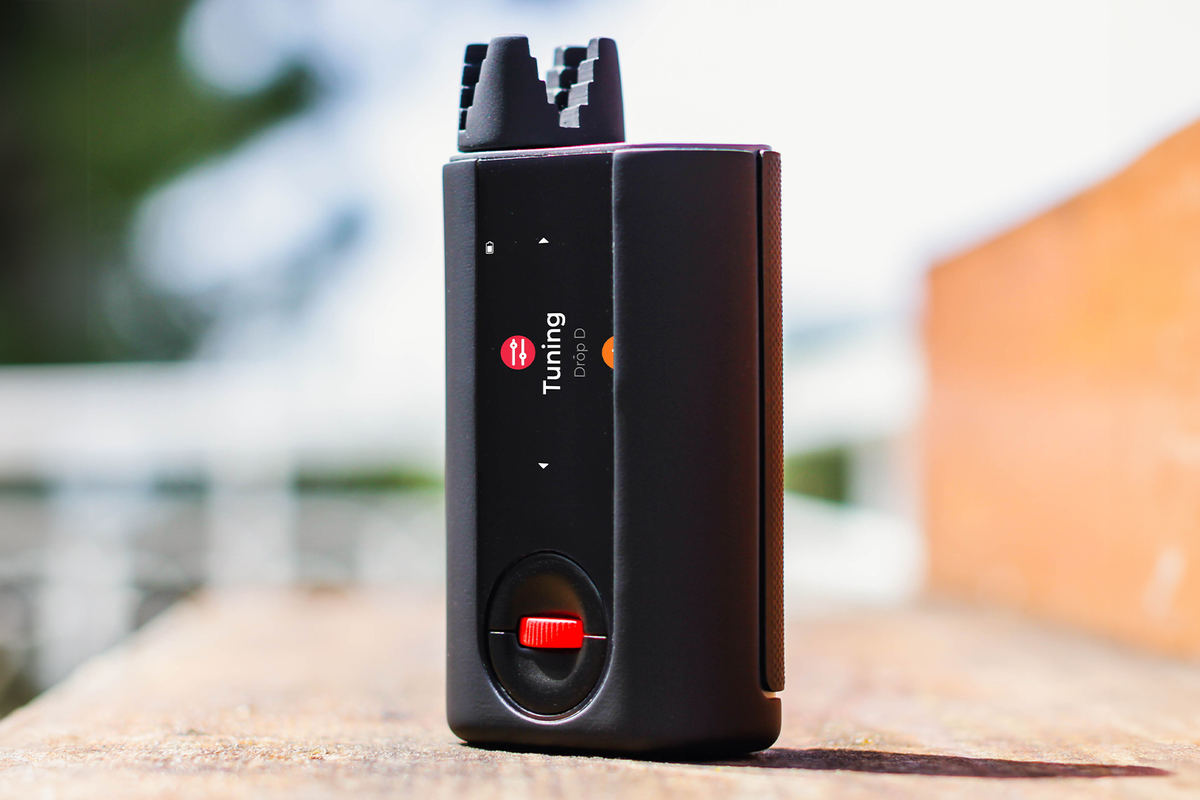
Band Industries has unveiled Roadie 4, the latest generation of the company’s innovative automatic tuners.
Designed for fast, reliable tuning for nearly any instrument with geared pegs, the new tuner is built from the ground up with enhanced accuracy and usability. Roadie 4 delivers a smoother, faster, and more reliable tuning experience. With revamped algorithms and upgraded audio circuitry, it offers excellent noise immunity and pinpoint tuning accuracy, whether you're tuning on stage, in a noisy rehearsal room, or at home.
Key new features include:
- Completely reengineered algorithms and audio circuitry for superior tuning accuracy and better performance in noisy environments
- Larger 1.9" full color LCD screen with over twice the display area for greater visibility when tuning
- New intuitive scroll wheel for lightning fast selection and navigation
- Auto detect feature: In previous models, Roadie tuned your instrument in a fixed sequence lowest to highest string or required manual string selection. Now, just pluck any string. Roadie 4 will automatically detect which string you are on, tune it precisely, and notify you when it is in tune with a vibration and audible beep
- Redesigned peg connector to accommodate a wider range of larger and smaller pegs
- Improved ergonomics: Taller build, anti slip backing, and a more natural, secure grip
Band Industries introduced the original Roadie Tuner in 2014, followed by the breakout Roadie 2 in 2017 and the powerful Roadie 3 in 2020. Roadie 4 builds on that legacy and provides even better performance.
From electric and acoustic guitars to mandolins, ukuleles, banjos, and more, Roadie 4 tunes almost any instrument with geared pegs. It also winds new strings quickly and accurately, making string changes a breeze.
Roadie 4 is available for street price of $139. For more information visit roadiemusic.com.
Goose's Rick Mitarotonda: Can Jambands Write Great Songs? Yes!
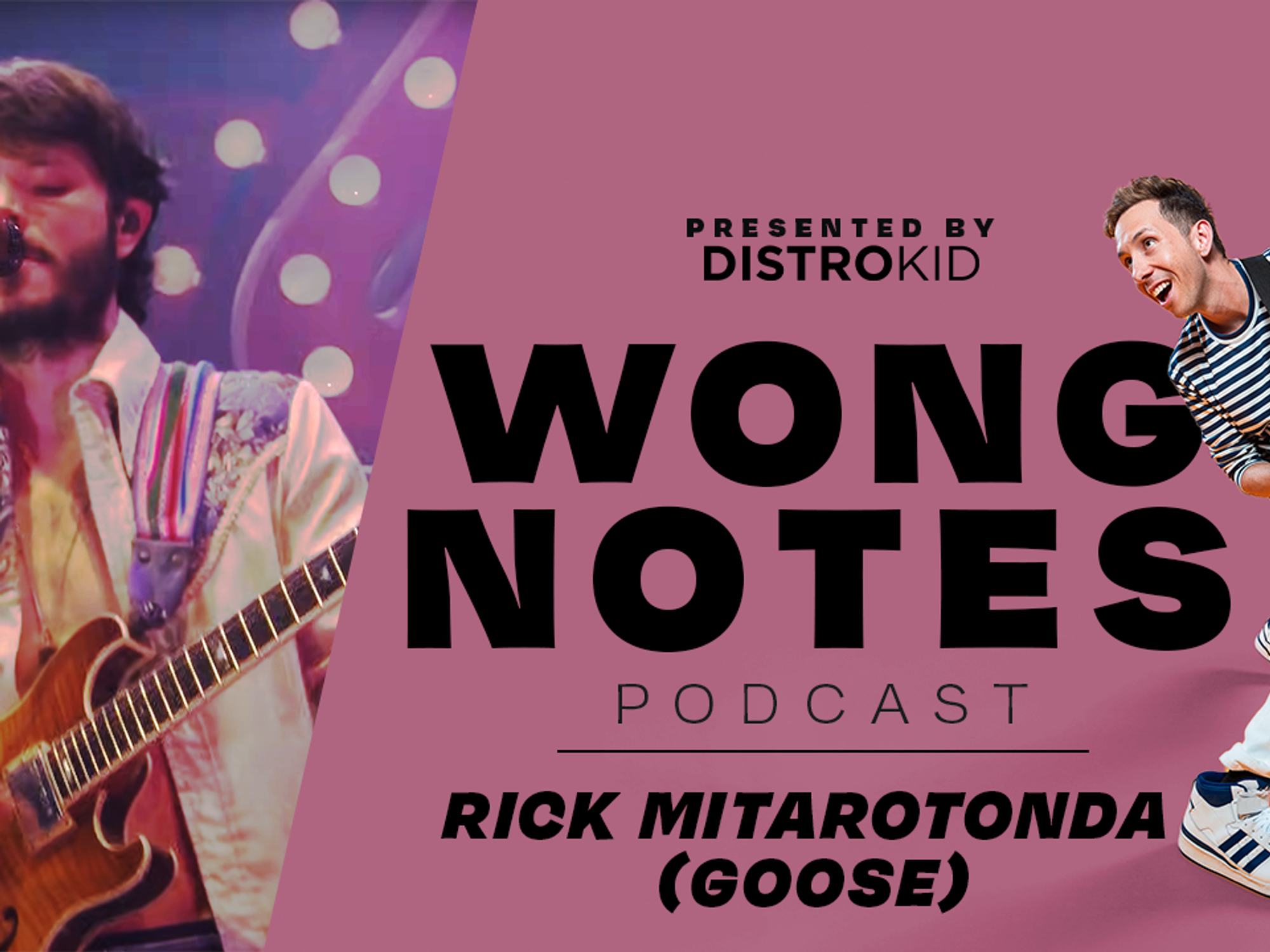
Cory Wong and Mitarotonda go deep on jambands, feeling misunderstood, and more.
Sound the alarms, tell your neighbors, hire a banner plane: Wong Notes is back. Cory Wong’s beloved podcast returns after a healthy break, and this exciting comeback episode features Wong in conversation with Goose’s Rick Mitarotonda.
The Connecticut rock band’s guitarist and vocalist talks through the band’s origins and position in the jam-band and broader music scenes, and Wong and Mitarotonda debate an ancient, critical question: Can jam bands actually write great songs?
The duo talk through their philosophies on recording, staying sharp on your instrument, all-star moments and standout players in the jam community, and feeling misunderstood as an artist. Like a good jam set, there are plenty of rich tangents, fascinating rabbit holes, and unexpected insights, so tune in and keep your ears open.
Blackstar Announces BEAM SOLO – Play Time.
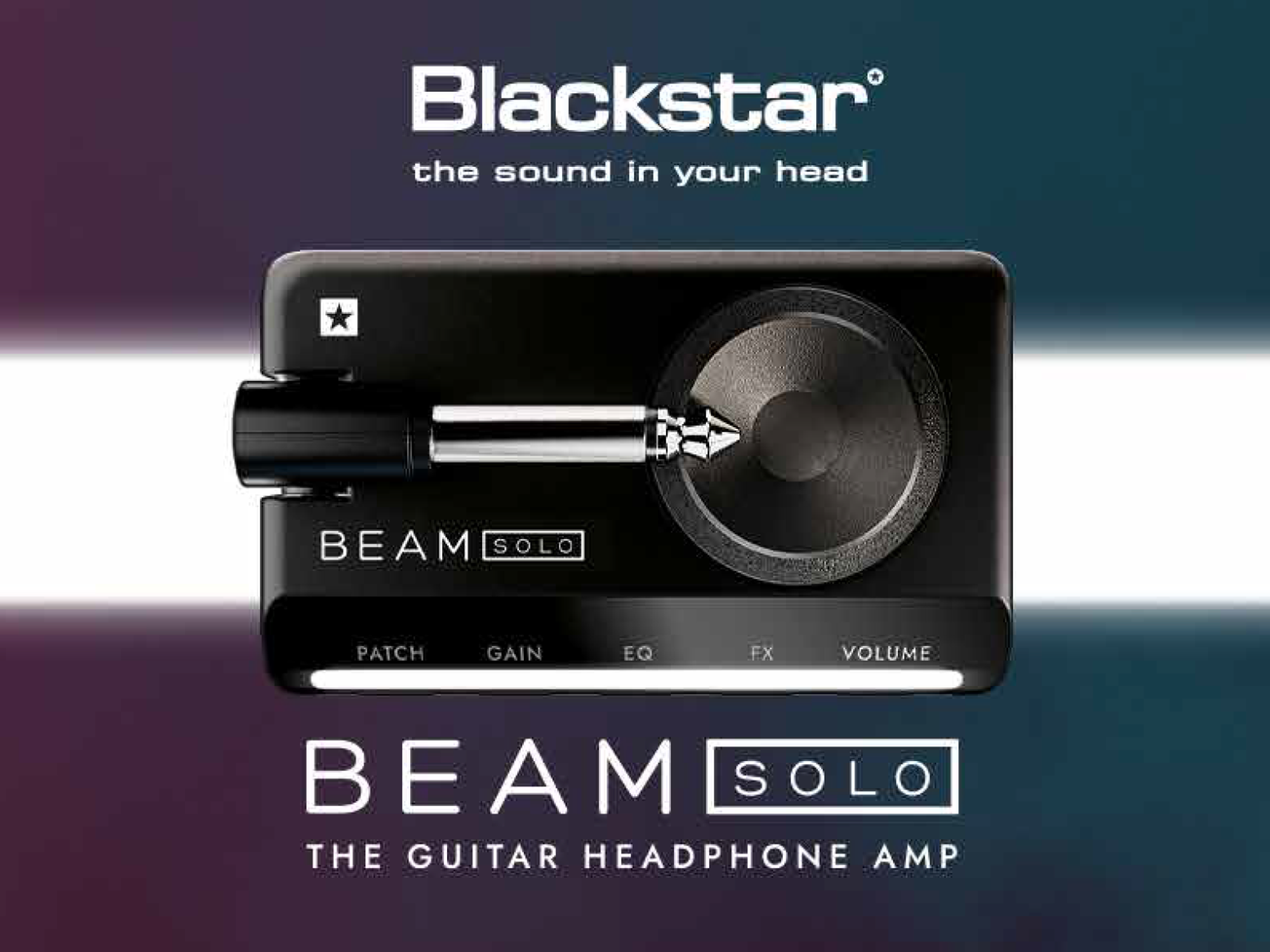
At Blackstar, we believe great tone should be ready whenever inspiration strikes. That’s why we created BEAM SOLO — the most immersive, intuitive headphone amp on the market today. Whether you’re jamming at home, on the move, or just grabbing ten minutes of play time between everything else, BEAM SOLO gives you pro-level sound with complete creative freedom — wherever you are.
Designed for electric, acoustic and bass guitars, BEAM SOLO fits in your hand, plugs straight into your headphones, and delivers the sound and feel of a real amp. You can shape your tone directly on the unit using the tactile SpeedDial and Light Beam Display, which give instant visual feedback with no menus to navigate. Or you can take full control through the BEAM app, where a growing library of professional-grade amp, cab, mic and pedal models is waiting. Combined with our patented ISF, you can access an infinite number of tonal possibilities to explore, enjoy and create with.
With our unique and immersive ‘In The Room’ technology, we’ve made the headphone experience feel alive — like a real amp, in a real space. Every note resonates with depth and presence, making even silent practice inspiring. A single expressive control called XpressFX lets you control multi-layered effects in real time, with smooth transitions that feel natural when adjusting. We’ve also added a headset mic input with studio-quality preamps and reverb, so you can truly immerse yourself with both guitar and vocals wherever you are, and jam along to your favourite tracks seamlessly via Bluetooth audio.
In addition to the authentic Blackstar amp models, BEAM SOLO also includes Ampton – our collection of classic software amplifiers, designed at Blackstar HQ in Northampton UK – home to our world-class R&D department. Built on decades of experience in both valve and digital amplifier design, Ampton fuses authentic valve character with advanced digital algorithms, developed by a design team with a unique technical heritage. The name itself is drawn from Northampton, reflecting the roots of our engineers and the history behind the company.
Ampton designs are more than just static profiles, they are the result of meticulous design, testing and optimisation – component by component, sector by sector. Starting with Blackstar founder Bruce Keir’s original digital models of our legendary Series One valve amplifiers, every element has been refined over decades. This dedication extends to the tiniest tonal interactions, from cathode follower behaviour to the modelling of preamp DC offsets, ensuring unmatched realism, tone and feel.
Another unique aspect of the Ampton designs are the completely accurate tone-stack models. These retain the exact interactivity between controls as the valve amp references, to deliver musicality and interactivity that a mere “capture” snapshot cannot. The power amplifier models go beyond traditional emulation, recreating the true interplay between valves, output transformers and speakers.
Our method blends deep analysis and literally hundreds of hours of critical listening. AB sonic tests are matched with precise electrical analysis, while the design team use their decades of voicing expertise. Every nuance is considered while intelligent optimisation results in elegant algorithms with extremely low latency.
If you head over to the BEAM app, you’ll find Official Artist Patches to explore from an ever growing list of all-stars including Doug Aldrich (The Dead Daisies), Gus G. (Firewind), Will Sergeant (Echo & The Bunnymen) and many more. You can join in the fun and share your own tones on the online community and download other creators’ patches within a vibrant global community of players just like you. You can even share your favourite patches over message to your friends with just a simple tap.
Within the ‘Music’ section of the app, you’ll find a host of backing tracks and video lessons to make sure that you can stay inspired and continue your learning journey. The BEAM SOLO is a complete one-stop solution for guitar players today.
We designed BEAM SOLO to give every guitarist the freedom to play and create anywhere, instantly, and without compromise. Whether you’re shaping your sound with a twist of the SpeedDial or diving deep into your rig choices via the app, it always feels intuitive and immersive. You can record vocals, jam with backing tracks, or just enjoy the feel of a cranked valve amp in your headphones — all from a device that fits in your pocket.
We’re constantly adding new sounds and features to the BEAM app, so your rig evolves with you. With ISF, XpressFX, SpeedDial, Light Beam Display and community connectivity, BEAM SOLO gives you the tools to stay inspired, have fun and sound incredible — wherever you are.
Alter Bridge Release First Track/Video “Silent Divide”
On the heels of the excitement from the recent announcements of their upcoming 8th studio album and their Blackbird festival in Wales next summer, acclaimed rockers Alter Bridge are releasing the first piece of music in over two years, “Silent Divide.” The track from the quartet comprised of Myles Kennedy on vocals/guitars, Mark Tremonti on guitars/vocals, Brian Marshall on bass and Scott Phillips on drums shows the band is back and ready to pick up where they left off in 2023. The brooding track begins with the signature guitar tones of Kennedy and Tremonti before the rhythm section of Marshall and Phillips join in. The chorus is powered by Kennedy’s haunting descent as he sings: “Keep your head down, ride out the silent divide.”
A music video for “Silent Divide” is also available today that the band has been teasing for days. A comedic opening skit was released of Tremonti, Marshall, and Phillips calling Kennedy’s mom to get the band back together as Myles hangs in his mom’s basement. That scene gives way to a performance of the 4 guys playing together in a small room – a throwback to the way it all started for them. The video was directed by JT Ibanez, and the song can be found in all formats here:
With more than two decades performing together, Alter Bridge show no signs of slowing down. The new, self-titled album from Napalm Records, Alter Bridge, is comprised of 12 all new tracks from the band and features some of their most iconic moments on record. Songs like “Rue The Day,” “Disregarded” and “Scales Are Falling” will fit alongside any of the classic songs from Alter Bridge’s catalog. “Trust In Me” shows Myles and Mark sharing vocal duties as Myles handles the verse duties while Mark takes the chorus. That strategy is flipped on “Tested And Able” as Mark handles the verses and Myles takes on the choruses behind one of the band’s heaviest intros to date, giving way to an unforgettable melody. The album closer “Slave To Master” is an epic track that Alter Bridge has come to be known for and is the longest song the quartet has recorded to date. The band worked with longtime collaborator and producer Michael “Elvis” Baskette on their eighth album. Alter Bridge will be released on January 9, 2026, and is now available for pre-order at: https://www.lnk.to/AB-AlterBridge.
The track listing for Alter Bridge is:
1) Silent Divide (5:06)
2) Rue The Day (4:46)
3) Power Down (4:08)
4) Trust In Me (4:48)
5) Disregarded (3:55)
6) Tested And Able (4:36)
7) What Lies Within (5:07)
8) Hang By A Thread (4:11)
9) Scales Are Falling (5:54)
10) Playing Aces (4:05)
11) What Are You Waiting For (5:00)
12) Slave To Master (9:03)
To coincide with the release of the new music, Alter Bridge is announcing a headline U.S. tour to accompany their already announced European tour. The band is heading out on the What Lies Within U.S. Tour featuring Filter or Sevendust and Tim Montana as support in select markets. The tour kicks off on April 25 in Orlando, FL and runs through May 24 where it wraps in Tampa, FL. Along the way, the tour will make stops in Dallas, TX (April 29), Chicago, IL (May 6) and Huntington, NY (May 12) to name a few. More information on all tickets and VIP packages for the upcoming tour can be found at www.alterbridge.com.
What Lies Within U.S. Tour
Apr 25 – Orlando, FL – House of Blues – TM
Apr 26 – Atlanta, GA – Coca-Cola Roxy – 7D/TM
Apr 28 – Houston, TX – Bayou Music Center – F/TM
Apr 29 – Dallas, TX – South Side Ballroom – F/TM
May 1 – Tulsa, OK – Skyline Event Center at Osage Casino Hotel – F/TM
May 2 – Omaha, NE – Steelhouse Omaha – F/TM
May 5 – Green Bay, WI – EPIC Event Center – F/TM
May 6 – Chicago, IL – The Salt Shed – F/TM
May 9 – Atlantic City, NJ – Event Center at Borgata Hotel Casino & Spa - F
May 10 – Boston, MA - Citizen House of Blues Boston – F/TM
May 12 – Huntington, NY – The Paramount – F/TM
May 13 – Montclair, NJ – The Wellmont Theater - F/TM
May 18 – Pittsburgh, PA – The Roxian Theatre – F/TM
May 19 – Detroit, MI – The Fillmore Detroit – F/TM
May 21 – Nashville, TN – The Pinnacle – 7D/TM
May 22 – Birmingham, AL – Avondale Brewing Company – F/TM
May 24 – Tampa, FL – Seminole Hard Rock Tampa Event Center – F/TM
Previously announced What Lies Within Tour Dates
Jan 15 – HAMBURG, GERMANY – Sporthalle
Jan 17 – OSLO, NORWAY – Sentrum Scene
Jan 18 – OSLO, NORWAY – Sentrum Scene
Jan 20 – STOCKHOLM, SWEDEN – Annexet
Jan 22 – HELSINKI, FINLAND – Ice Hall Black Box
Jan 24 – COPENHAGEN, DENMARK – KB Hallen
Jan 25 – BERLIN, GERMANY – Columbiahalle
Jan 27 – GLIWICE, POLAND – Prezero Arena Gliwice
Jan 28 – BUDAPEST, HUNGARY – Barba Negra
Jan 30 – VIENNA, AUSTRIA – Gasometer
Jan 31 – ZAGREB, CROATIA – Bocarski Dom
Feb 02 – ROME, ITALY – Atlantico
Feb 03 – BERGAMO, ITALY – ChorusLive Arena
Feb 05 – ZURICH, SWITZERLAND – The Hall
Feb 06 – LYON, FRANCE – Halle Tony Garnier
Feb 08 – BARCELONA, SPAIN – Razzmatazz 1
Feb 10 – LISBON, PORTUGAL – Sagres Campo Pequeno
Feb 12 – MADRID, SPAIN – Palacio Vistalegre
Feb 13 – BORDEAUX, FRANCE – Arkea Arena
Feb 15 – LUXEMBOURG, LUXEMBOURG – Rockhal
Feb 17 – OBERHAUSEN, GERMANY – Oberhausen Turbinenhalle
Feb 18 – PARIS, FRANCE – Zenith
Feb 20 – MUNICH, GERMANY – Zenith
Feb 22 – AMSTERDAM, NETHERLANDS – Ziggo Dome
Feb 23 – BRUSSELS, BELGIUM – Ancienne Belgique
Feb 25 – NEWCASTLE, UNITED KINGDOM – Utilita Arena
Feb 26 – MANCHESTER, UNITED KINGDOM – AO Arena
Feb 28 – DUBLIN, IRELAND – 3Arena
Mar 02 – GLASGOW, UNITED KINGDOM – OVO Hydro
Mar 04 – LONDON, UNITED KINGDOM – The O2
Mar 05 – NOTTINGHAM, UNITED KINGDOM – Motorpoint Arena
Jun 27 – CARDIFF, WALES – Blackbird Festival @ Cardiff Castle
Back in 2004, four lifelong musicians got together down in Florida. Even though they had traveled separate paths, similar lessons learned, wisdom earned, and dues paid united these gentlemen—Myles Kennedy [vocals, guitar], Mark Tremonti [guitar, vocals], Brian Marshall [bass], and Scott Phillips [drums]—as Alter Bridge. Over the ensuing two decades, the band endured countless trials and tribulations, defied every odd, and rose to the head of the pack as a hard rock juggernaut, cementing a singular legacy by selling out arenas, gathering nearly 1 billion streams, inciting international acclaim, and quietly attracting a diehard audience. Beginning with the Top 5 entry of 2004’s gold certified One Day Remains, the band have scored six consecutive Top 20 debuts on the Billboard 200. Among a myriad of highlights, Guitarist Magazine applauded “Blackbird” for the “Greatest Guitar Solo of All Time,” the ABIII single “Isolation” vaulted to #1 on the Billboard Mainstream Rock Chart, 2013’s Fortress received rare perfect scores from KERRANG! and Total Guitar, and Walk The Sky shook the Top Rock Albums Chart at #1. Beyond packing O2 Arena and Royal Albert Hall, Classic Rock hailed 2022’s Pawns & Kings as “the Rolls-Royce of Alter Bridge records” in a 4.5-out-of-5-star review. Plus, the latter LP garnered praise from American Songwriter, Guitar World, and Loudwire, while Billboard christened them “one of America’s premiere hard rock quartets.” Channeling the same hunger, the band continue to push themselves on their self-titled eighth full-length offering, Alter Bridge [Napalm Records]. It embodies everything they’re known for such as the precise riffs, towering hooks, and solos that practically break guitar strings as they burst through the clouds.
Strymon Introduces New PCH Stereo Active DI
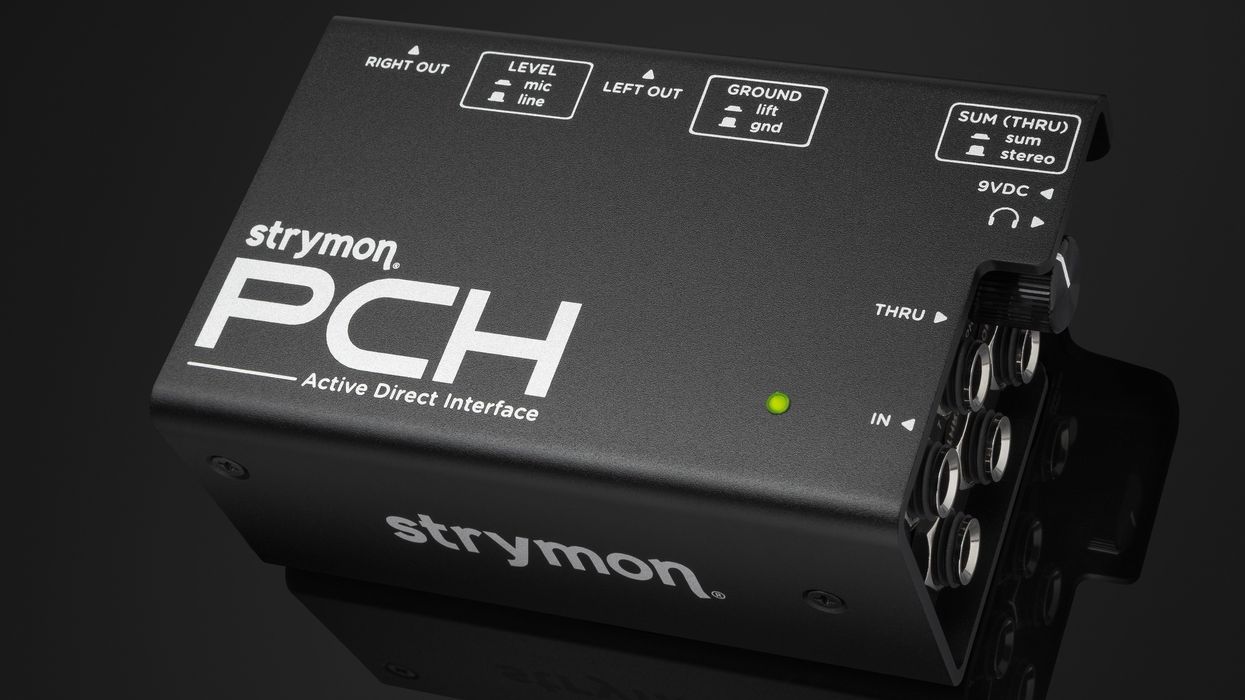
Strymon Engineering has introduced the new PCH Stereo Active Direct Interface, an advanced stereo direct box with a built-in headphone amplifier.
Featuring impressive specs that out-perform DIs anywhere near its price range, PCH also has a unique feature expected to delight pedalboard users: a powerful built-in headphone amp, loud and clean enough to drive even high impedance headphones.
Now you can rest easy knowing that the sound of your pedalboard won’t change even a little when passing through PCH, and the headphone amp means you won’t have to ask anyone how you sound. You’ll know.
PCH makes it easy to monitor or practice while listening to the sound of your entire rig or pedalboard in full stereo. No matter what instrument or style of music you play, if you need to connect unbalanced outputs to a PA, recording interface or flat response speaker system, PCH is the ultimate choice for an absolutely transparent stereo direct interface - and it’s the only one that you can listen to locally via the stereo headphone amp.
Housed in a battle-ready 3mm extruded aluminum chassis, PCH requires 9VDC power, which it converts internally via a custom single-channel Ojai power supply to 24VDC. That extra voltage and high current renders the interface nearly un-clippable, and allows it to achieve a max signal-to-noise ratio of 135db, a hyper-flat frequency response of +/- 0.25db from 10Hz to 80 KHz, and gives the headphone amplifier enough power to cleanly drive even 600 ohm headphones without distortion.
PCH features include:
• Two channel design - use in stereo or dual mono, whichever fits your setup
• Runs on 9VDC - internally converted to 24V to be virtually unclippable
• Stereo headphone amplifier powerful enough to drive high impedance headphones
• Switchable Mic/Line level operation for the XLR outputs
• Defeatable ground lift for the XLR outputs
• Defeatable Sum for the Thru outputs
• Runs off of a modified internal mini Ojai power supply for ultimate performance
• Extremely low THD (Total Harmonic Distortion)
• Bulletproof construction that will stand up to the abuse of the road
“As the music world continues to embrace quiet stage volumes, instrumentalists increasingly turn to amp-less live rigs to achieve good tones at low volumes”, said Sean Halley, Strymon’s Head of Marketing. “Unfortunately this creates problems for players trying to hear their entire pedalboard when they’re anywhere else but onstage. With a PCH at the end of your signal chain, you get a pristine direct interface and a killer built-in headphone amp to make sure that what you’re sending to the PA or recording rig is exactly what you intend to - and it makes silent practicing a joy.”
Gregg Stock, Strymon co-founder and analog circuit guru adds “while we’re more recognized for our DSP effects pedals, they wouldn’t sound the way they do if the analog side wasn’t just as advanced. With PCH we’ve brought that analog expertise to a new market, because it doesn’t matter whose pedals are on your board, you need a bulletproof and pristine-sounding DI to interface with the outside world. PCH isn’t just for guitarists, it’s for anyone with a pedalboard.”
The PCH Active Stereo DI is available now directly from Strymon and from dealers worldwide for $279 US.
Wampler Cryptid Review
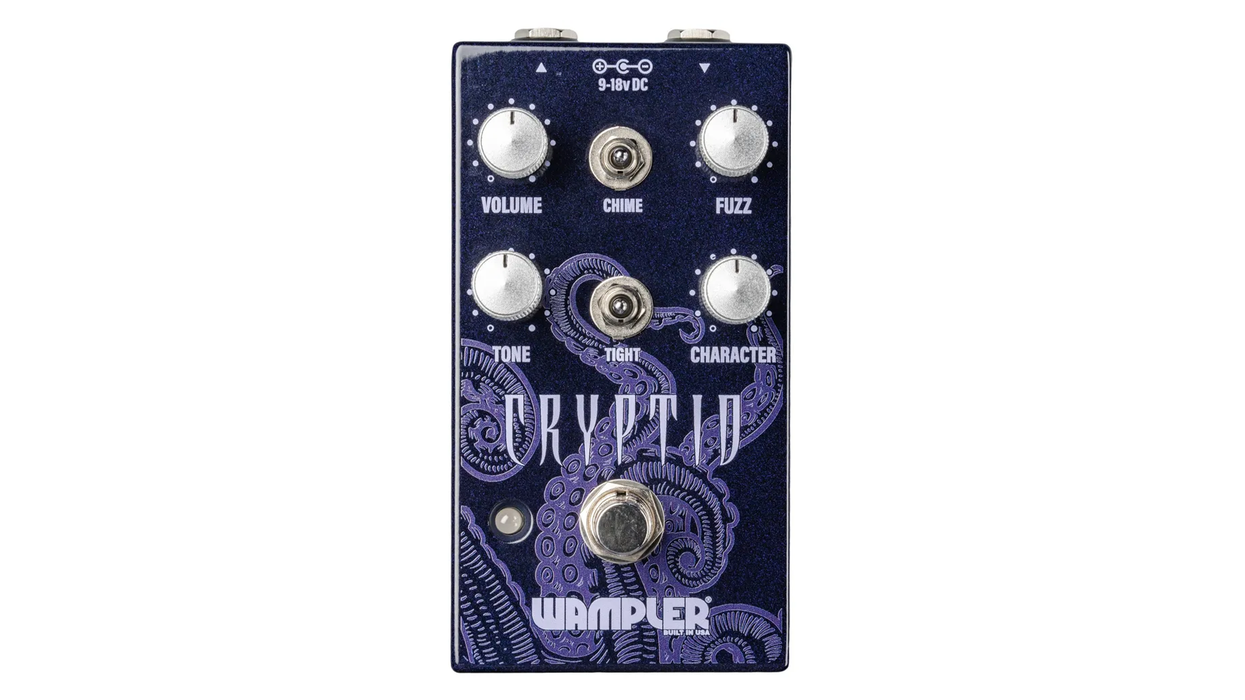
Since hitting the scene in 2007, Wampler has consistently made some of the better overdrive and distortion pedals on the market. Interestingly, though, other than 2013’s Levithan fuzz and its brazen sibling, the Fuzztration, which is a fuzz/octave pedal, Wampler’s product line didn’t feature many fuzz pedals. Since then, Brian Wampler has evolved as a pedal builder, and Wampler’s new Cryptid reflects a unique take on what a fuzz can be—employing a newly designed circuit with NPN and PNP transistors, and FETs.
Wampler has described the Cryptid as a “fuzz for those who don’t like fuzz.” And certainly, it’s a versatile pedal that covers much more sonic ground than conventional fuzzes. In addition to delivering variations on familiar classic Fuzz Face, Tone Bender, and Big Muff sounds, the Cryptid can move into light overdrive or even chiming clean territory.
A Fun House of Fuzz
The Cryptid, despite the implied mystery in its name, is pretty forgiving. You could just set all the knobs at noon and you’d be good to go for any number of fuzz tasks and roles. But this is a fuzz of impressive potential, and every knob and switch—particularly the character knob and the tight and chime switches, and the way they interact—can profoundly reshape the pedal’s performance and feel.
The character knob is a bias control that can shift the mood and responsiveness of the pedal significantly. When the character knob is fully counter-clockwise, the Cryptid is well behaved and focused. As you turn it clockwise, though, things get crazier. Once the character knob is around 2:00 you’ll start to hear sputtering textures that evoke tired, voltage-starved vintage units and more deliberately designed glitch fuzz.
The tight switch lets you regulate how much bass is present in the signal and has a pretty significant impact on the tone. In the down position, it adds in a fair amount of bass. The middle position offers the least bass content and tightens up the sound, which brings out more overdrive-like colors. The up position is the ticket to maximum bass, and even with the fuzz knob set conservatively the Cryptid really is explosive and massive.
The chime switch adds high end. The down position gives a little bit of chime, the middle position is relatively chimeless and has a darker quality, and the up position yields the brightest sounds. The less fuzz you apply to the signal, the more noticeable the chime effect will be. With the fuzz knob all the way counter-clockwise and the chime control switch in the up position, you get delicious, pronounced near-clean tones that fit the bill for Hendrix double stops and Stevie Ray Vaughn blues escapades.
Brian Wampler’s ambitions in putting together the Cryptid—essentially encapsulating the character and tonalities associated with Big Muffs, Tone Benders, and Fuzz Faces, while leaving room for airy, cleaner tones and picking dynamics—were far-reaching. But there is ample evidence that he achieved his aims. Cryptid may not serve many purists searching for classic clone sounds, but it offers the chance to create more original sounds that have all the fire of those classics, and more polite tones to boot.
From Metal Crunch to Country Clean: The Rise of Revv Amps
John Bohlinger sits down with Revv Amps’ cofounder Derek Eastveld to trace the company’s journey from basement builds to pedal boom. And while their Generator Series fire-breathing amps and pedals started its ascent finding homes with rockers The Pretty Reckless & A Day to Remember, Eastveld explains that it might be their clean, versatile Dynamis Series gear that's making the Canadian brand a preference for players and producers in Nashville.
Ella Feingold and Charlie Hunter: A Rhythmic Symposium
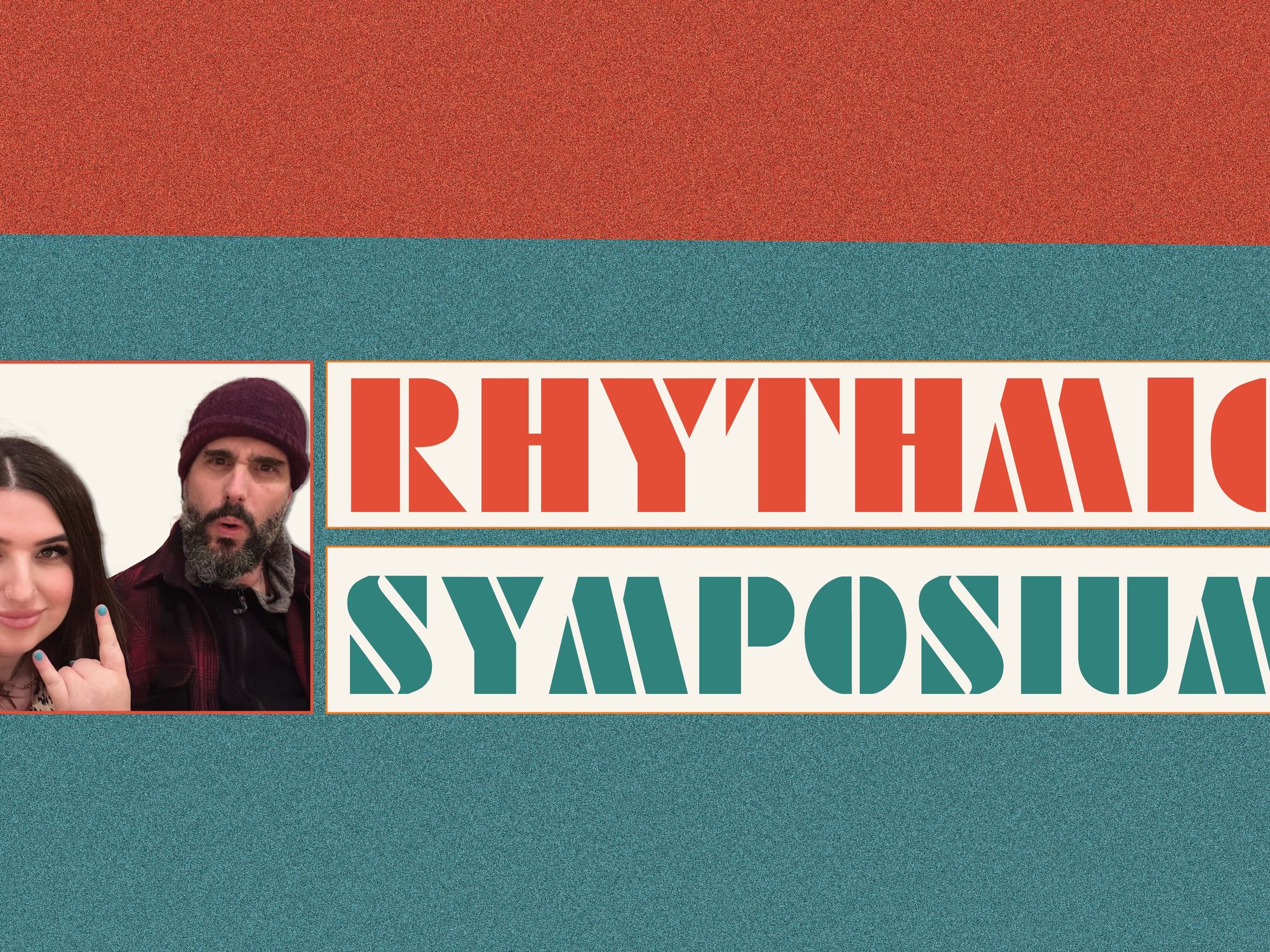
When it comes to rhythm guitar, there are acknowledged masters—artists like Jimmy Nolen, Catfish Collins, Wah Wah Watson, Curtis Mayfield—whose work deserves deep analysis and interpretation. But the discourse on each and every one of these players is sadly thin. That’s because rhythm—especially when it’s funky—is ineffable, and it’s much easier to discuss licks, riffs, melodies, or gear than it is to talk about the give-and-take nuances that make your body want to move when you hear a song. Like Icarus and the sun, if we try to describe a groove too closely we’re setting up our demise. In the attempt to convey those truly human elements of musical performance, we not only fail, but risk rendering ourselves … unfunky.
YouTube
It’s not just words that fall short—musical notation can’t quite capture a groove either. Though it does well at communicating a composer’s intended notes and rhythms, transcribing the intricacies of feel is a task that often overcomplicates something so intrinsic to human nature to the point of illegibility. In learning from the greats of funk, soul, and r&b guitar, we simply have to use our ears as best we can.
“I think we probably share like 60 to 75 percent of our musical DNA. And then the extra stuff that we have adds something to it.” —Charlie Hunter
For some, that only goes so far, so we need visual aides. And that’s how most people—probably—discover Ella Feingold, the Grammy-winning guitarist breaking down the intricacies of those masters of rhythm guitar and many others on Instagram and TikTok, making some of the greatest strides yet in the education—and enjoyment—of funky feel. We’re talking deep, below-the-surface details, like pick attack and note placement—potentially nerd-level stuff that she delivers in a warm, approachable style that makes her videos so engaging and rewatchable. (In fact, if there’s one person I’ve learned the most about guitar from in the last couple of years, it is Ella.)
Feingold’s rhythmic research is backed by a deep resume that spans work as an orchestrator, composer, and producer. As a guitarist, Feingold has been tapped to play alongside an impressive list of leaders that includes Erykah Badu, Silk Sonic, Bootsy Collins, and Jay-Z.
Charlie Hunter is one of many who found Feingold through Instagram. After Hunter—who came up in the ’90s on Blue Note Records, famously wielding a hybrid guitar/bass instrument that set the jazz-funk scene on high alert—scrolled across Feingold’s videos, the two quickly took it to their DMs and established a friendship. Collab talks started soon after. Feingold, who has worked exclusively as a side musician save for a few classical piano pieces, jumped at the opportunity to release a record under her name alongside Hunter, who she lovingly calls “a musical hero.”
The two convened at Pilot Studios in Great Barrington, Massachusetts, with producer Alan Evans—best known as the drummer for Soulive—for a few short days to create Different Strokes for Different Folks, a rhythm symposium of the highest order. It’s a record that’s earnestly old-school by way of a simple approach: capturing a live-off-the-floor two-way conversation between singular instrumentalists. Feingold’s guitar—punchy and percussive but still delicate and detailed—lies on the right side of the stereo field throughout, communing with Hunter’s counterpoint of pulsing bass, which sits near the center, and snare-like guitar chords and knotty riffs on the left. No-frills drums, added by Hunter, pull together the sound, unifying the feel and tying the record to groove masters like Stevie Wonder and Sly Stone—the latter referenced in the album title and its opening track, “There’s Still a Riot Goin’ On.”
“Sly is just my god, my king of dark funk.” —Ella Feingold
Different Strokes for Different Folks is a masterwork of minimal funk: there are no solos, and melodies arise from rhythm itself. It’s an album that draws attention to the finer details of rhythm guitar, and to the communication between rhythmic elements that are often relegated to background duty. Most importantly, it’s an album that will make you feel something.
We got together with Feingold and Hunter to talk rhythm, recording, and the art of musical conversation.
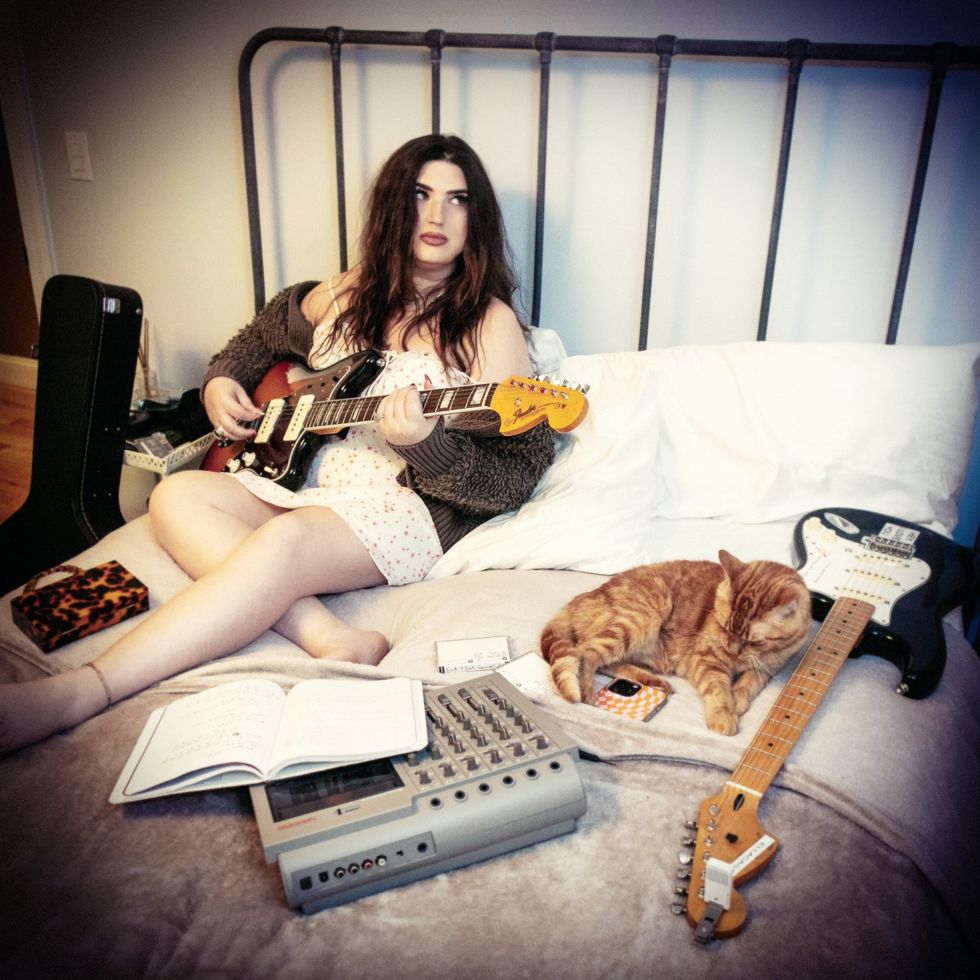
After first meeting on Instagram, what was the catalyst for making the record happen, and how did it come together?
Ella Feingold: I’ve always been a fan of Charlie’s, obviously. Eventually, it led to just talking all the time, about rhythm and all the stuff we love that doesn’t really get discussed a lot. We had a lot in common, and at some point, he’s like, “Yeah, we should make a record together…” which kind of terrified me.
Charlie Hunter: I think we probably share like 60 to 75 percent music DNA. And then the extra stuff that we have adds something to it. I have all this really old knowledge that nobody cares about, like 1920s stuff. And then I always tell people, “You want to know about this one Motown recording from 1968?” Call Ella, because she’s going to know exactly who played on that and exactly every part.
Feingold: We knew we wanted to do a record together. But in terms of the drumming, we had talked about everything from programming an MPC to just having a funk box—a Rhythm King, a Rhythm Ace—to getting drummers. We had talked to Steve Jordan, and Steve was like, “I’m down.” We had talked to Questlove, Questlove was down. And I know this sounds like the douchiest thing in the world to say—because to have musicians like that that are interested in working with us is the grandest honor—Charlie and I, we just wanted the conversation to be between the two of us. We wanted the rhythm to be this mantra that feels good, that moves you to the conversation we’re having, but that’s not the forefront of the conversation.
So it started with us going in, knowing that the rhythm is going to come from him and I, but not exactly sure how. And then with me programming a little bit with the MPC and playing along. Then Charlie replaced everything and killed it on drums. So Charlie’s the drummer on the record. And what I think is cool about that is we wanted it kind of like … when Sly Stone plays drums, and when Stevie Wonder plays drums, or when Lenny Kravitz, whoever, like an artist that plays their own music, does the drum part, it’s going to be exactly what it needs to be and nothing else, with no other filler, no other musicianship, no “look what I can do.” It’s going to be exactly what needs to be there. And that’s exactly what Charlie did.
Hunter: Because I don’t take pride in my drumming, we wanted it to just be as basic as possible.

Ella, there are so many songs you talk about on your social media that I’ve heard a million times, but you’ll show how a part goes and then I’ll hear it so differently. It blows my mind. You have such a good ear for really fine details, and I know a lot of people feel that way.
Feingold: I feel like I get too much credit. A lot of that stuff just comes from what I can’t do—meaning I don’t really solo, I don’t know modes, I don’t really know a lot of scales. There’s so much I don’t know. My ear just goes to the place that makes my ear happy.
I think some of it has come from being on the road in the early 2000s, when there were no stems, no stem-making software, there wasn’t really social media. You had to learn a show from a rehearsal CD or an MP3 and had to pick out guitar parts. You really had to do this kind of deep listening to try and hear stuff.
“If you have a good feel and something to say and a lived experience, you got this.”—Ella Feingold
There are two references to Sly Stone on the album—the title is a lyric from “Everyday People,” and the song “There’s Still a Riot Goin’ On” is a hat-tip to Sly’s 1971 record.
Hunter: That’s Ella’s department. She is a Sly-o-phile.
Feingold: Sly is just my god, my king of dark funk. You obviously have George Clinton and James Brown, but something about Sly, for me, it’s just the greasiest, most raw, tasteful … it’s something that just hits me in the chest. A lot of my musical aesthetic was from Sly and from him playing all the instruments. And then all the music I adore—D’Angelo and J Dilla and some Prince—it all comes from Sly.
If I can get political, I’m a trans woman, and we did that album in February, a month after the inauguration, after Trump was going after trans people, taking away life-saving medicine and hormones and fucking with our passports and all kinds of stuff. And I felt a lot of turmoil. So going into the record, it just felt like there was a riot going on—externally in the world and internally within. And I just wanted some of that to be reflected in the conversation. Not just because I love Sly and the Sly references. Certainly “different strokes for different folks” came out of the lyrics, but it’s cool because “different strokes” can also be referring to Charlie’s stroke and my stroke on the instrument, and there’s also the Muhammad Ali reference—knocking people the fuck out.
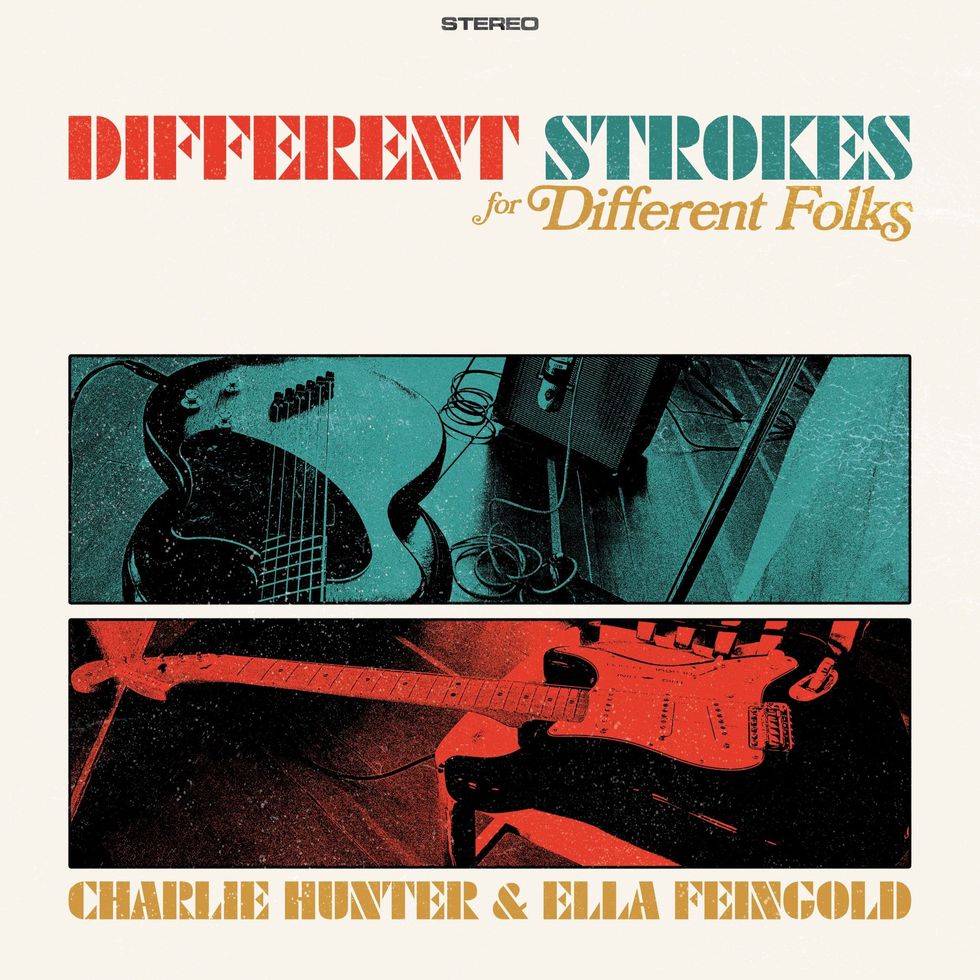
Tell me about the guitars you used on the record, and the tunings.
Feingold: I used a Mexican Strat in inverted tuning—it’s E–A–D–G–B–E, but it’s high to low, not low to high, so familiar voicings become distant relatives.
Where did the inverted tuning come from?
Feingold: From my buddy Blake Mills [who learned it from Chris Weisman]. I even have the text message where he said, “I’m about to change your life.” For me, the appeal was it gave me the rhythm sound I wanted in terms of attacking the high strings first. And the tuning felt a little familiar, because it’s related to standard. Although anything above a triad, the overtone series sort of gets put on its head—all the color tones are on the low strings and all the roots and thirds are on the high strings. But it opened up this whole new world of harmony that was like Claus Ogerman harmony—close position stuff you’d hear Nat King Cole or George Shearing play. What I love is it’s sort of similar to Charlie’s whole journey, which he took long before I did, of, “What does this thing want to be?” And then finding a sound with it.
“The first time we played, I was like, ‘This sounds like a gigantic lawnmower guitar that can take buildings down.’” —Charlie Hunter
Hunter: I think there’s also something really special that happens because of Ella’s inverted tuning and the fact that it’s basically in E, while my hybrid tuning is basically an F. Every tune, we each have a different set of open notes and a different overtone series that makes the instruments do this really cool shimmery thing together. The first time we played, I heard that and I was like, “This is dope. This sounds like a gigantic lawnmower guitar that can take buildings down. All right, let’s go do this.”
Charlie, your journey with your instrument has been well documented at this point, but catch us up a little bit.
Hunter: I started on this 8-string guitar, and that was really a bad idea. And I made a bunch of records on it. I just was like, “Hey, Ralph Novak [of Novax Guitars], can you make this? I have an idea. Could be cool.” Never thinking this was going to be my career. Before I knew it, I had a deal with Blue Note. And then I'm like, “My god, I can’t really do this very well. It’s so hard. What am I doing?” It took me years to figure out, “What does this instrument want to do?”
So I hooked up with Hybrid Guitars and I settled on this thing I’m calling the Big 6. What this instrument does best is really more like a drum set, where you have bass and guitar and it’s all about the counterpoint. It has an extra long scale—the lowest string is 31 inches and the highest is 28.
I have it tuned F, Bb, Eb—which are the lower three strings of a bass, up a half-step—which sends me into a hell of transposition, but sounds so much better than E. And the guitar [side] is Bb, Eb, Ab, which is essentially A, D, G up a half-step.
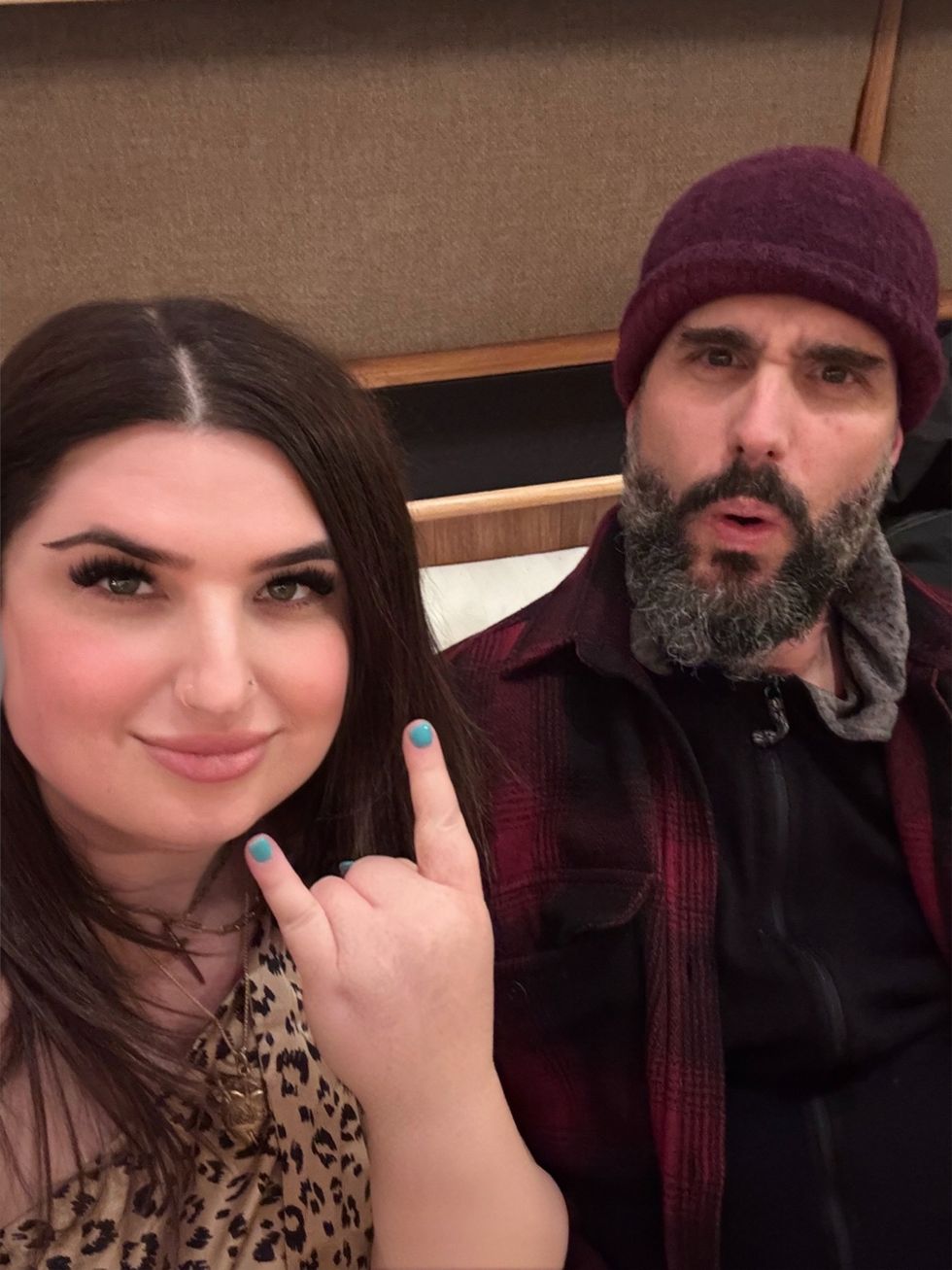
Ella Feingold’s Gear
Guitar
Fender Jimi Hendrix Stratocaster with Fender Custom Shop Fat ’60s pickups and inverted tuning
Amp
1968 Fender Princeton Reverb
Effects
Ensoniq ASR-10 used for envelope filter
Strings and Picks
La Bella inverted tuning custom signature set (.046 E; .032 B; .017 G; .026 D; .016 A; .011 E)
D'Addario Ukulele 3.0 mm
Charlie Hunter's GearGuitarHybrid Guitars Hybrid 6 (aka Big 6)AmpTwo-Rock Studio SignatureAmpeg B-15Acme Audio Motown DIEffectsSurfyBear Compact DeluxeStringsThomastik-Infeld Jazz Flat Wound (bass side)Thomastik-Infeld Pure Nickel Round Wound (guitar side)
What was the biggest revelation that came from working together?
Hunter: For me, it’s just that we have a great time playing together, and I just learned a ton, you know? And if I can take that away from any situation, it’s a win.
Feingold: The gift of working with Charlie is it gave me the confidence to make my own music. Because I’ve spent my entire career helping other people with their music, playing on their records or producing. I’ve never invested in my own music because I always thought you have to make your own, like, Pet Sounds or Sgt. Pepper’s—you’re going to be working, writing for years. And it was like, we went in there, we had some ideas over a couple of months, and it turned into over an hour of music.
And it just was like, “Wow, I’m overthinking this stuff like crazy.” If you have a good feel and something to say and a lived experience, you got this. That was kind of an unexpected gift. After Charlie and I finished mixing the record, I bought a four-track and I made an EP. I was really inspired by just being around Charlie.
So if you have something to say in the moment, that’s it. That’s the most important thing.

